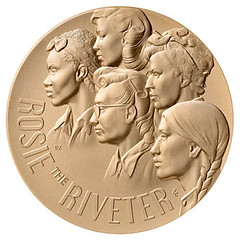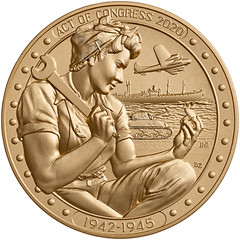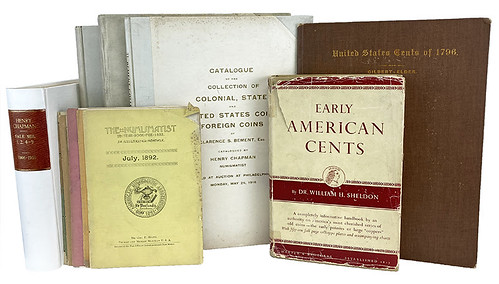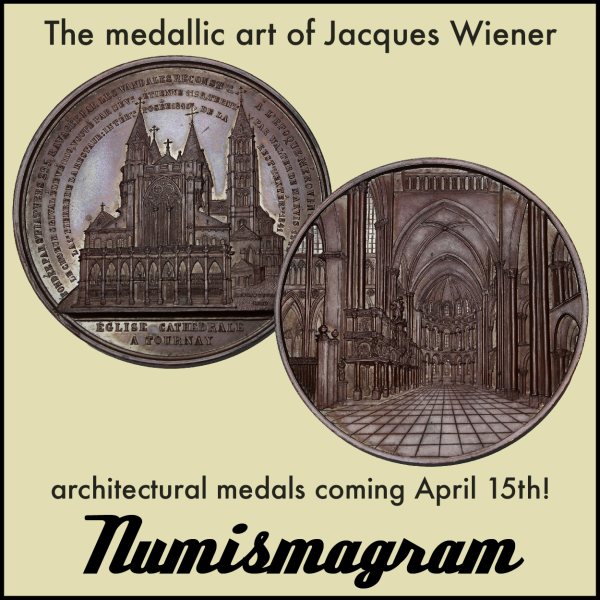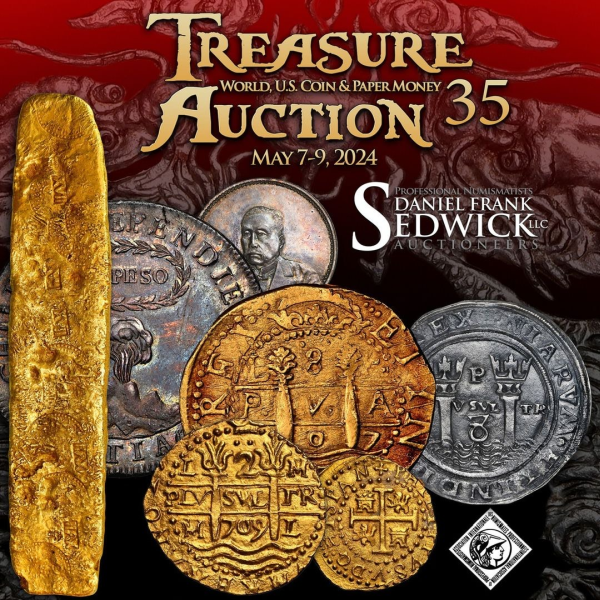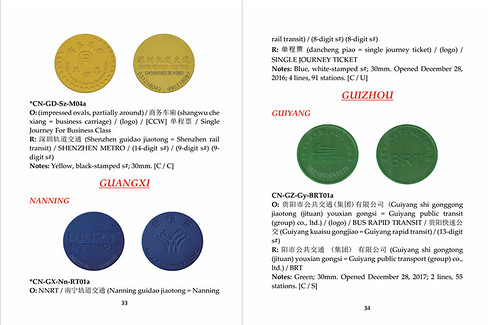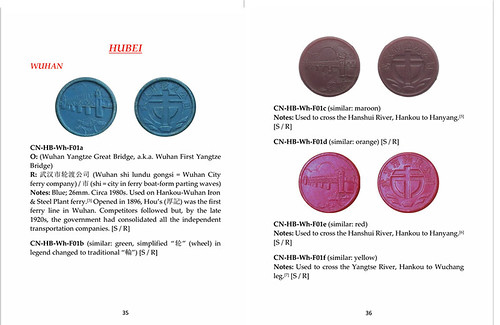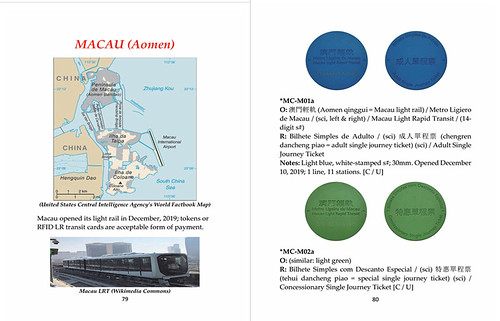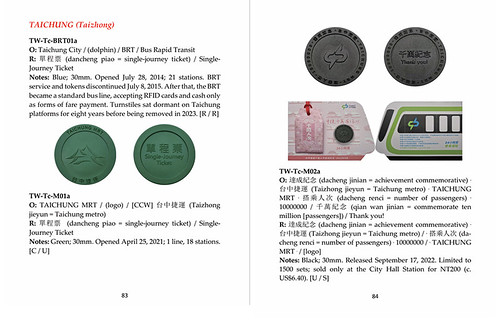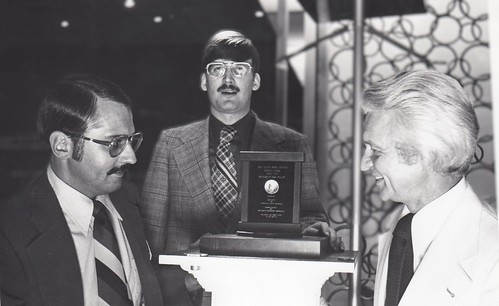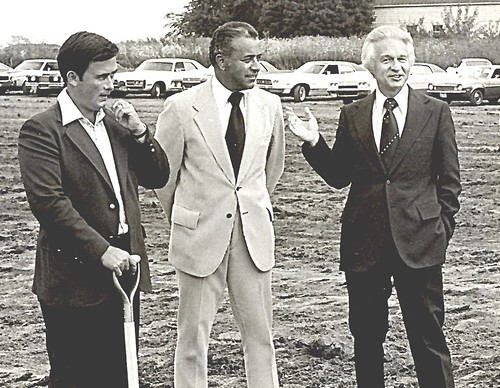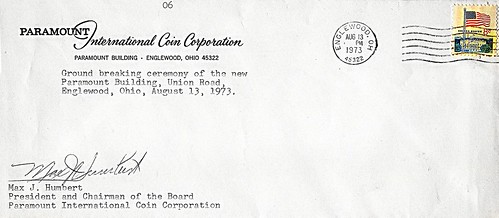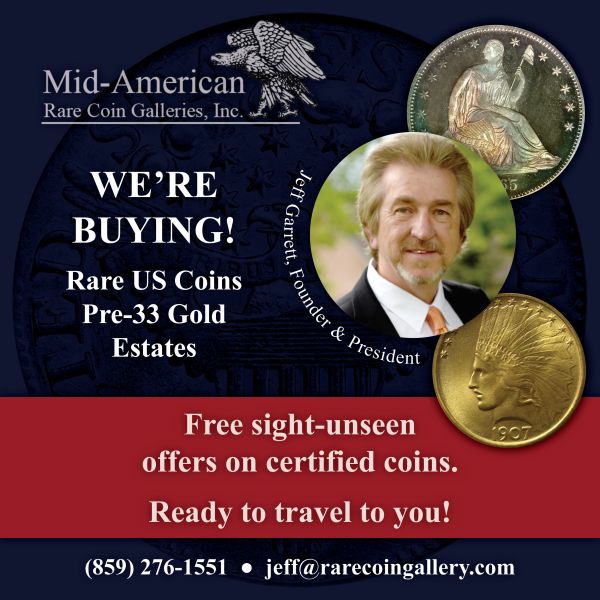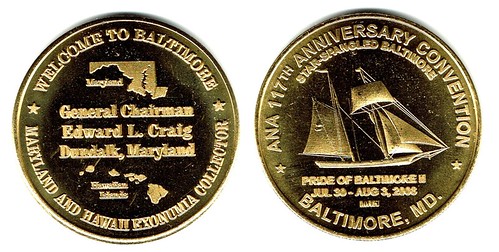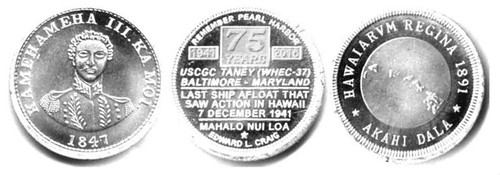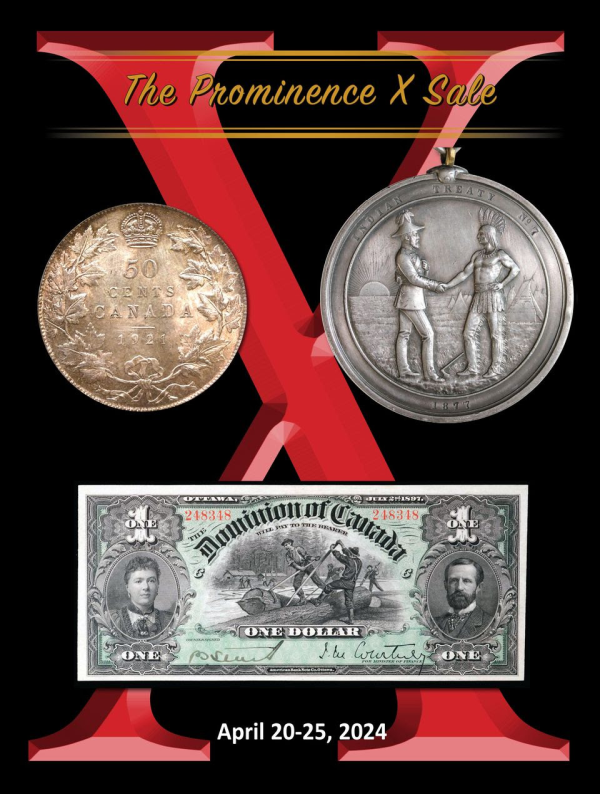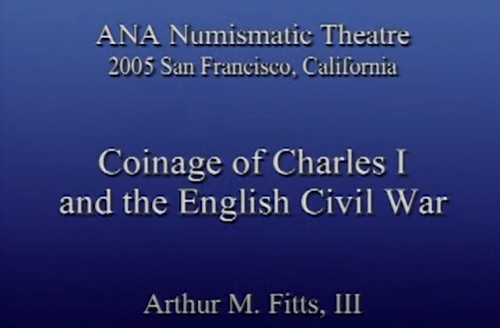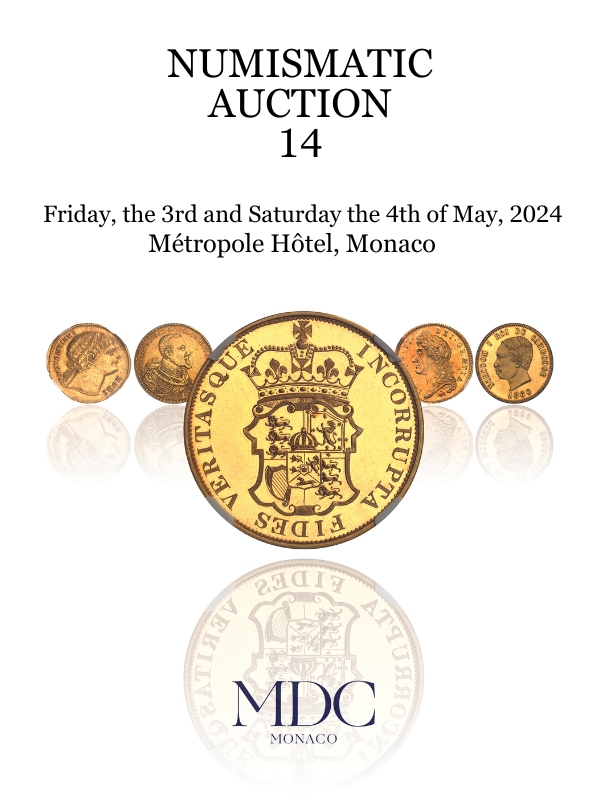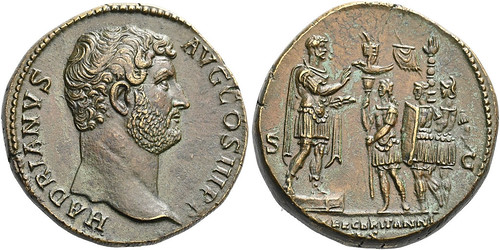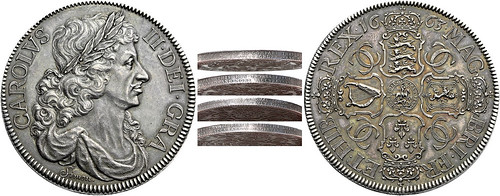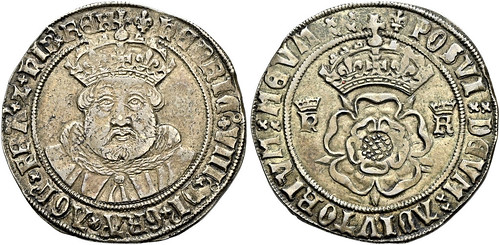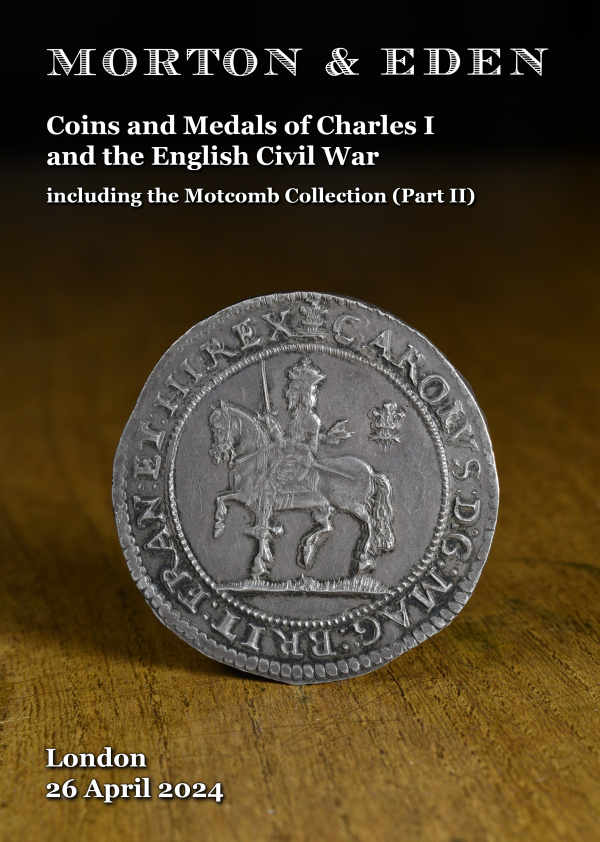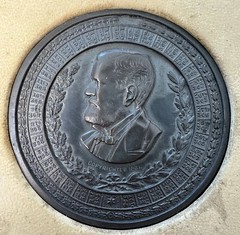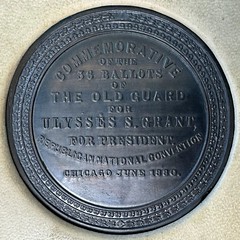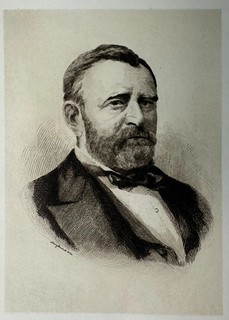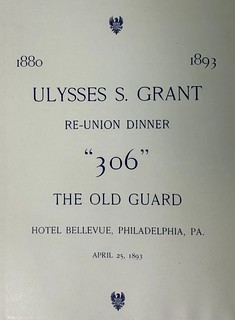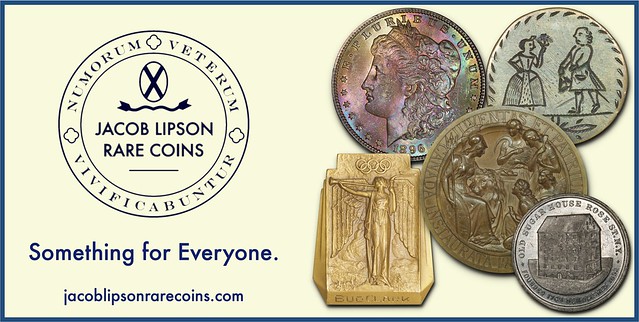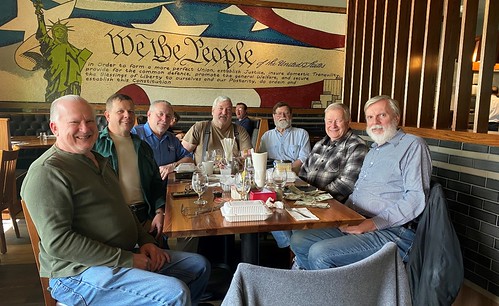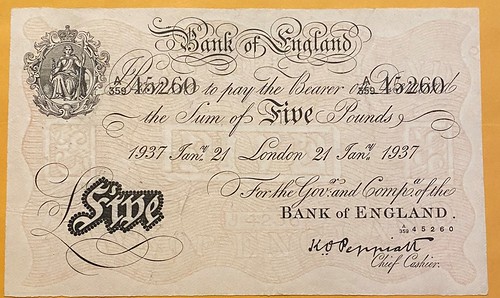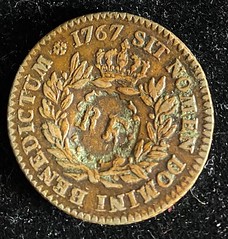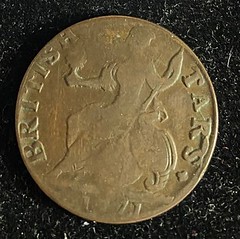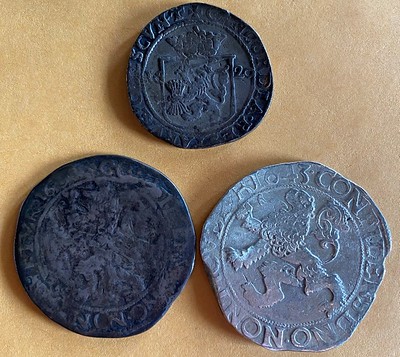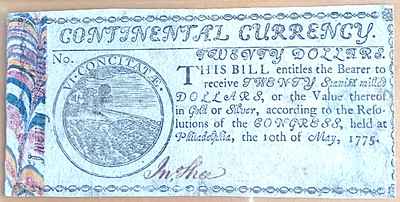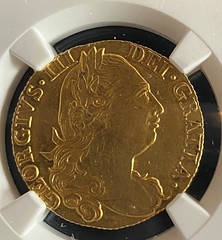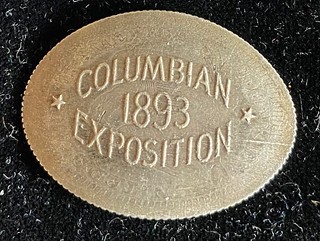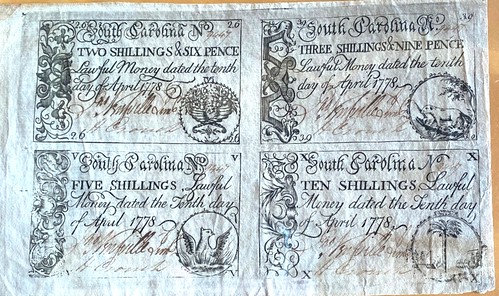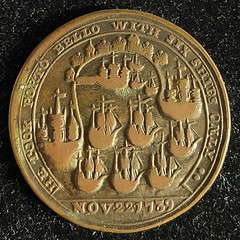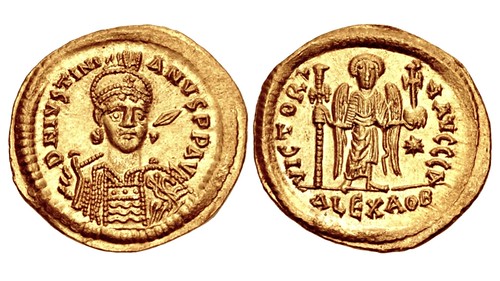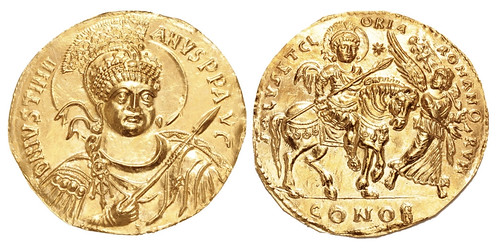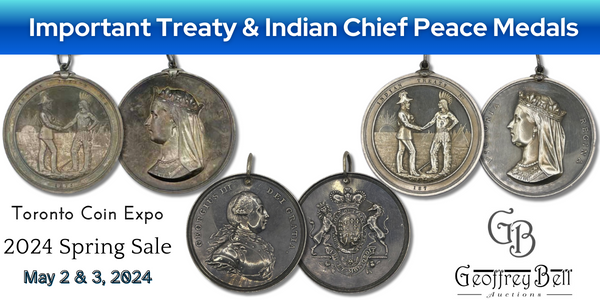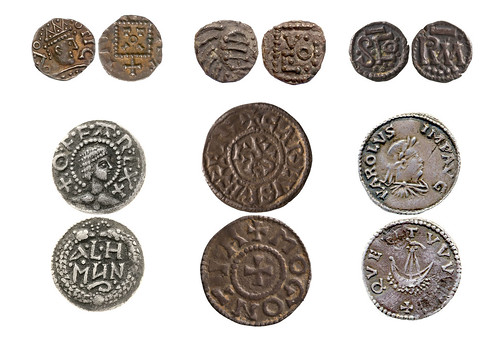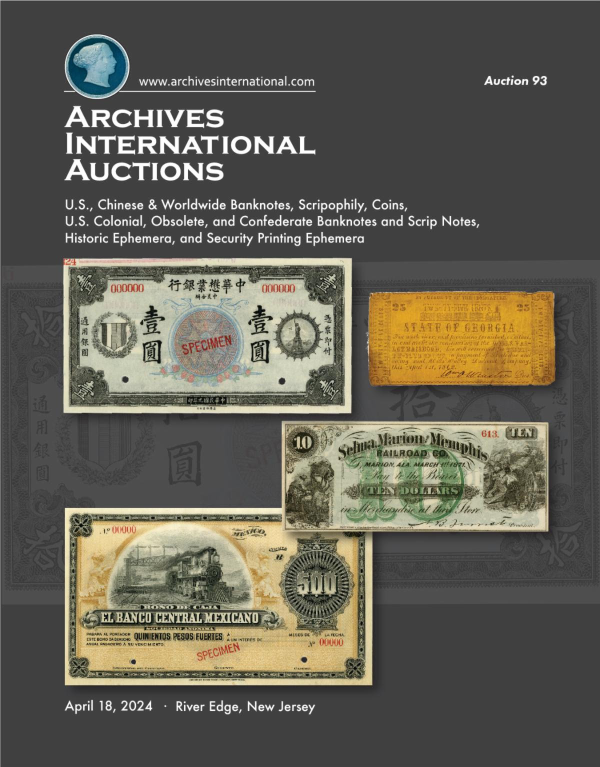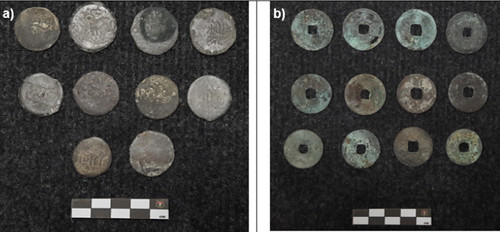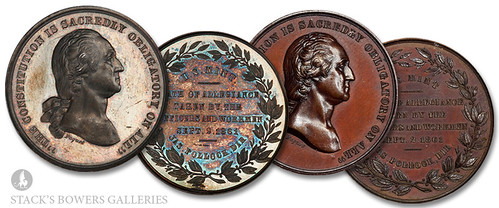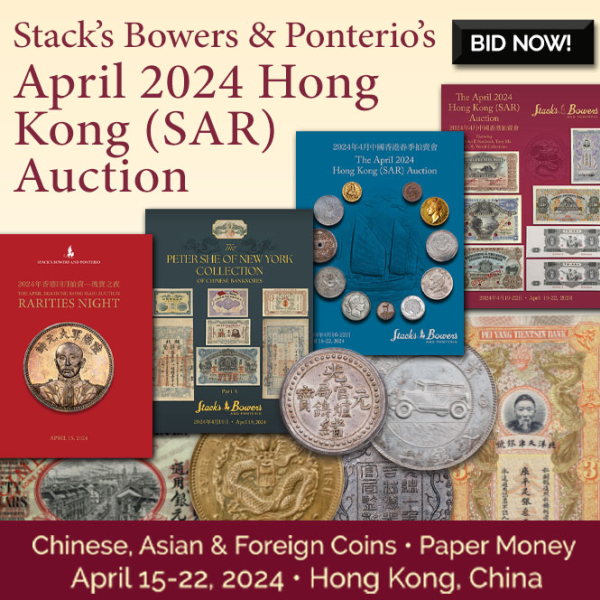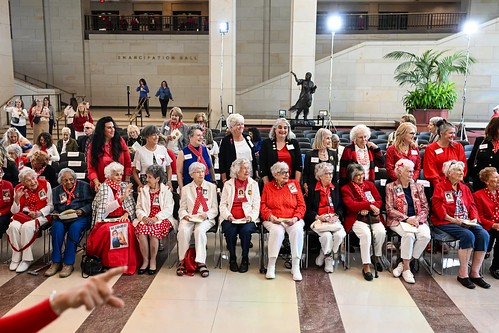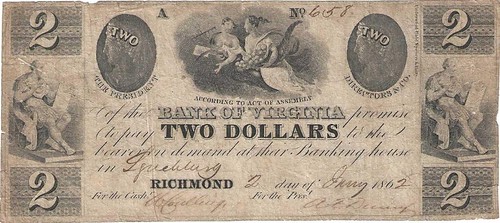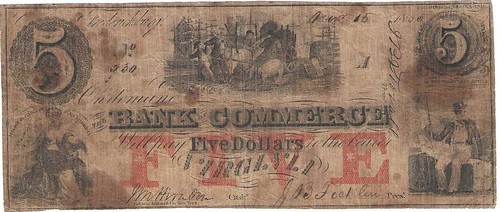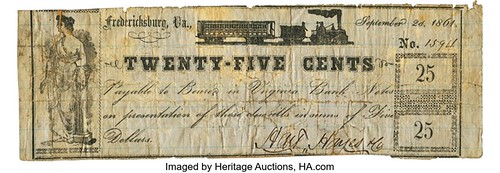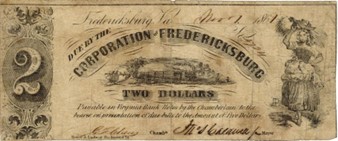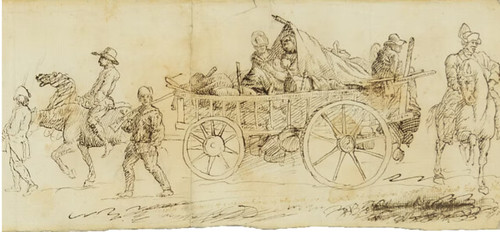
Visit our NBS Sponsors
About UsThe Numismatic Bibliomania Society is a non-profit association devoted to the study and enjoyment of numismatic literature. For more information please see our web site at coinbooks.org SubscriptionsThose wishing to become new E-Sylum subscribers (or wishing to Unsubscribe) can go to the following web page link MembershipThere is a membership application available on the web site Membership Application To join, print the application and return it with your check to the address printed on the application. Print/Digital membership is $40 to addresses in the U.S., and $60 elsewhere. A digital-only membership is available for $25. For those without web access, write to: Jeff Dickerson, Treasurer AsylumFor Asylum mailing address changes and other membership questions, contact Jeff at this email address: treasurer@coinbooks.org SubmissionsTo submit items for publication in The E-Sylum, write to the Editor at this address: whomren@gmail.com BUY THE BOOK BEFORE THE COINSale CalendarWatch here for updates! |
- WAYNE'S WORDS: THE E-SYLUM APRIL 14, 2024
- NBS 2024 CHARITY AUCTION DONATIONS SOUGHT
- NEW BOOK: TETRARCHIC HOARDS FROM ROMAN BRITAIN
- NEW BOOK: CHARLTON CANADIAN COINS 77TH ED.
- NEW BOOK: NUMISMATIC DOCUMENTS OF THE HISPANIC CARIBBEAN
- NEW BOOK: PLASTIC TRANSPORTATION TOKENS OF CHINA
- MAX JACOB HUMBERT (1929-2024)
- RALPH JAMES WINTER (1944-2024)
- EDWARD LEE CRAIG (1946-2024)
- JOHN EDWARD GUSMANO (1963-2024)
- NNP ADDS TO CONGRESSIONAL REPORT SERIES
- VIDEO: COINAGE OF THE ENGLISH CIVIL WAR
- NOTES FROM E-SYLUM READERS: APRIL 14, 2024
- VOCABULARY TERM: PIERCING
- COPE COLLECTION OF BRITISH COINS OFFERED
- GRANT REUNION BOOK AND MEDAL
- THURSDAY LUNCH CLUB REPORT APRIL, 2024
- COINS OF JUSTINIAN THE GREAT
- ON COLLECTING BYZANTINE COINS
- BYZANTINE SILVER BECAME MEDIEVAL COINS
- MALAYSIAN SHIPWRECK COIN FIND
- CANADA'S FIRST AMERICAN VICTORIA CROSS
- U.S. MINT OATH OF ALLEGIANCE MEDALS
- ROSIE THE RIVETERS CONGRESSIONAL GOLD MEDAL
- PAPER MONEY OF FREDERICKSBURG, VA
- LOOSE CHANGE: APRIL 14, 2024
- DU SIMITIERE SKETCH DISCOVERED
- FEATURED WEBSITE: WHITMAN BRANDS
Content presented in The E-Sylum is not necessarily researched or independently fact-checked, and views expressed do not necessarily represent those of the Numismatic Bibliomania Society.
WAYNE'S WORDS: THE E-SYLUM APRIL 14, 2024
 New subscribers this week include:
Robert Warren.
Welcome aboard! We now have 7,291 subscribers.
New subscribers this week include:
Robert Warren.
Welcome aboard! We now have 7,291 subscribers.
Thank you for reading The E-Sylum. If you enjoy it, please send me the email addresses of friends you think may enjoy it as well and I'll send them a subscription. Contact me at whomren@gmail.com anytime regarding your subscription, or questions, comments or suggestions about our content.
We had no new books to report last week, an unusual occurrence lately. But not this time. This week we open with FOUR new books (that's great!), FOUR obituaries (that's not so good), updates from the Newman Numismatic Portal, and more.
Other topics this week include Canadian coins, the numismatic of Puerto Rico, Cuba, and the Spanish Caribbean, Chinese transportation tokens, Paramount International Coin Corporation, making dies for elongated coins, the English Civil War, the 1893 Grant Reunion, Justinian the Great, coin finds, and U.S. Mint Oath of Allegiance medals.
To learn more about the London Mint of Constantius and Constantine, Max Humbert, Congressional Reports with numismatic content, starting Teletrade, a numismatic earworm, the Cope Collection, the American who earned a Canadian Victoria Cross, the Rosie the Riveter Congressional Gold Medal, and Nigerian banknote abuse, read on. Have a great week, everyone!
Wayne Homren
Editor, The E-Sylum
NBS 2024 CHARITY AUCTION DONATIONS SOUGHT
Each year at the ANA World's Fair of Money, the Numismatic Bibliomania Society conducts a charity auction to raise funds for the organization. NBS President Len Augsburger submitted this announcement of this year's auction. Here's a repeat of last week's announcement with this important addition - potential donors must contact Len and auctioneer David Fanning by email before shipping. They may be reached at leonard_augsburger@hotmail.com and DF@numislit.com respectively. They'll need to monitor the volume and mix of material to ensure a successful auction. Thank you. -Editor
NBS Solicits Donations for 2024 Charity Auction
The NBS requests donations of numismatic literature for the 2024 Charity Auction, which will be held at the ANA convention in August. The Charity Auction covers a good portion of the NBS annual expenses, and we gratefully acknowledge past donors and bidders. While material at varied price points is welcome, we especially encourage donations of literature valued at $100 and up. Top honors from last year's sale went to Carl Würtzbach's annotated and plated copy of Henry Chapman's Bement sale (1916), donated by David Steine, which realized $3,000. Donations may be sent to NBS president Len Augsburger at 16 N. Fiore Parkway, Vernon Hills, IL 60061.
Link to previous NBS Charity Auction catalogs:
https://nnp.wustl.edu/library/auctioncompanydetail/512295
To read earlier E-Sylum articles, see:
2023 NBS BENEFIT AUCTION
(https://www.coinbooks.org/v26/esylum_v26n32a03.html)
NBS CHARITY AUCTION RAISES RECORD AMOUNT
(https://www.coinbooks.org/v26/esylum_v26n33a02.html)
NEW BOOK: TETRARCHIC HOARDS FROM ROMAN BRITAIN
Hugh Cloke of Georgetown University writes:
"The first of three important books on Roman coinage in Britain from the late third and early fourth centuries was published by the British Museum on March 24. The book is available to order in hard copy from the Museum, which has also published an open access, low resolution pdf edition of the book.
"Lee Toone and I are expecting that any day now we'll receive a set of revised pages for the new edition of our book, The London Mint of Constantius and Constantine, which we hope Spink will issue in May or June.
"The third book, Sam Moorhead's volume on the coinage of Carausius and Allectus, will be issued later this year as a part of the series Roman Imperial Coinage. Sam contributed a Forward to our upcoming book."
Thanks. Here's information on the first book. -Editor
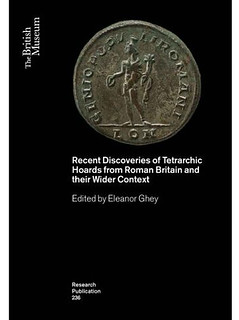 Recent Discoveries of Tetrarchic Hoards from Roman Britain and their Wider Context presents new research that will improve understanding of coin circulation in Britain.
Recent Discoveries of Tetrarchic Hoards from Roman Britain and their Wider Context presents new research that will improve understanding of coin circulation in Britain.
This volume was prompted by the recent discovery in Britain of two large coin hoards dating from the first decade of the fourth century AD – Wold Newton and Rauceby. Coins of this early Tetrarchic period are relatively uncommon finds in Britain and elsewhere, due mainly to the brevity of their periods of issue followed by successive reductions in the weight of the coinage. The book also republishes the 1944 Fyfield hoard within the context of these more recent finds and contains preliminary reports on two very large hoards of coins of the same period that have been found in recent years in France (Juillac) and Spain (Tomares).
The transition from the third to fourth century AD is a pivotal phase in the history of Roman Britain, with Britain reintegrated into the Empire following periods of turbulence and usurper rule between AD 260–296. The Roman Emperor Diocletian instigated the Tetrarchic system of rule in AD 293 to create stability, with the rule of the western and eastern Empire being split between two senior emperors and their junior colleagues. During this transitional period, the Empire was subjected to extensive monetary reforms, which saw the introduction of the denomination now referred to as the nummus, and a Roman imperial mint was established in Britain for the first time, in London. The volume therefore covers not just the hoards themselves, but also considers the wider significance of these hoards for Britain and the early fourth century monetary economy, particularly in the western Empire.
This book will serve as a useful resource for coin identification as the hoards contain many previously unpublished types.
AUTHOR:
Eleanor Ghey
PAGES:
406
FORMAT:
Paperback
DIMENSIONS:
H29.7 x L21cm
EXHIBITION:
9780861592364
ILLUSTRATIONS:
100
POSTAGE WEIGHT:
0.50 Kg
See the earlier article linked below for information on the Britannia Nummaria numismatic conference in York (18th July 2024), where the three new books will be officially launched. -Editor
To read the earlier E-Sylum article, see:
2024 BRITANNIA NUMMARIA CONFERENCE
(https://www.coinbooks.org/v27/esylum_v27n04a08.html)
For more information, or to order, see:
RP 236: Recent Discoveries of Tetrarchic Hoards from Roman Britain and their Wider Context
(https://www.britishmuseumshoponline.org/rp-236-recent-discoveries-of-tetrarchic-hoards-from-roman-britain-and-their-wider-context.html)
To read the open access, low resolution pdf edition of the book, see:
Recent Discoveries of Tetrarchic Hoards from Roman Britain and their Wider Context
(https://britishmuseum.iro.bl.uk/concern/books/c640c432-9184-49eb-9676-28f95b671655?locale=en)
For more on Roman Imperial Coinage (V, pt 5), see:
Carausius – A Usurper's Coinage on the Edge of Empire
(https://classicalstudies.org/%E2%80%9Ccarausius-%E2%80%93-usurper%E2%80%99s-coinage-edge-empire%E2%80%9D)
NEW BOOK: CHARLTON CANADIAN COINS 77TH ED.
The new 2024 Charlton Canadian Coins book is available. -Editor
2024-25 Charlton V1 Canadian Coins — 77th Edition
$36.95
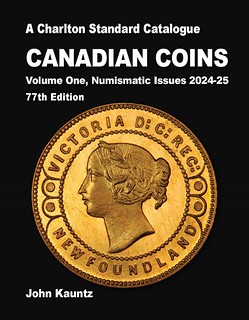 The 77th edition of the Charlton Vol 1 catalogue, unveiled on April 9, 2024, meticulously showcases, catalogs, and values the complete spectrum of Canadian coins spanning from the 1600s to the contemporary era. In addition to comprehensive coverage of circulating coinage, the catalogue features entries on foreign coins circulated in Canada during the 17th to 19th centuries, local pre-decimal coins, as well as coins originating from Nova Scotia, New Brunswick, Prince Edward Island, Newfoundland, and the Province and Dominion of Canada.
The 77th edition of the Charlton Vol 1 catalogue, unveiled on April 9, 2024, meticulously showcases, catalogs, and values the complete spectrum of Canadian coins spanning from the 1600s to the contemporary era. In addition to comprehensive coverage of circulating coinage, the catalogue features entries on foreign coins circulated in Canada during the 17th to 19th centuries, local pre-decimal coins, as well as coins originating from Nova Scotia, New Brunswick, Prince Edward Island, Newfoundland, and the Province and Dominion of Canada.
Furthermore, it encompasses sections dedicated to specimen coins, trial pieces, official fabrications, and test tokens. This year's edition of the catalogue also boasts Part 2 of the Canadian Coin Variety Catalogue (first edition) authored by Hans Zoell.
Weight 0.60 kg
Dimensions 23 × 20 × 2 cm
For more information, or to order, see:
2024-25 Charlton V1 Canadian Coins — 77th Edition
(https://coinstampsupplies.com/product/2024-25-charlton-v1-canadian-coins/)
NEW BOOK: NUMISMATIC DOCUMENTS OF THE HISPANIC CARIBBEAN
Ángel Navarro Zayas has published a new book in Spanish compiling important numismatic documents relating to Puerto Rico, Cuba, and the Spanish Caribbean. Congratulations! It's available in print-on-demand on Lulu.com. Below is a Google-translated description. -Editor
Documentos Numismáticos del Caribe Hispano (Siglo XIX)
Numismatic Documents of the Hispanic Caribbean (19th Century)
By Ángel Navarro Zayas
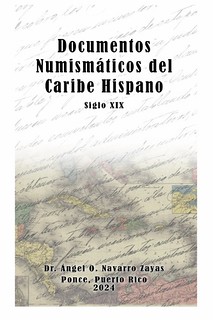 Numismatics is a branch of history that analyzes coins, paper money (notafilia), exonumia and medals, among other subspecialties. Marks of rulers, civilizations, and historical events are frequently seen on coins and banknotes, making them a valuable tool of historical information. It is recognized that one of the sovereign symbols of a country or nation is the minting of coins for general circulation.
Numismatics is a branch of history that analyzes coins, paper money (notafilia), exonumia and medals, among other subspecialties. Marks of rulers, civilizations, and historical events are frequently seen on coins and banknotes, making them a valuable tool of historical information. It is recognized that one of the sovereign symbols of a country or nation is the minting of coins for general circulation.
The research and study of coins allows for a better understanding of the economic, political and cultural history of a civilization. Coins and medals serve to preserve the rich cultural legacy of a nation or group of nations. This is what happens with the documents we present here. Our object of study for this research has been to recover from the National Historical Archive in Madrid, primary documents that deal with the Hispanic region of the Caribbean in the 19th century, including Cuba, Hispaniola and Puerto Rico.
To facilitate access for numismatic researchers, the primary documents obtained through the Spanish Online Archives Portal have been transcribed in their entirety.
One of the first files included in the publication here deals with the use of the coin currency in Puerto Rico. In addition, other files from the National Historical Archive address the issue of the use of macuquina currency in Puerto Rico in the mid-19th century. Likewise, in another file the use of the resampling of the 1884 Puerto Rican coins with the countermark of the Fleur de Lis is discussed – that is another slightly more detailed document – which in my opinion has not been studied by numismatists in Puerto Rico. The documents also address the actions carried out by the Puerto Rican authorities to prevent the introduction of silver coins with holes in them. On the other hand, an original printed handwritten document is included that analyzes the Monetary Question in Puerto Rico, written by Enrique Vijande. The document presents several perspectives from various prominent people and entities related to government and commerce in the context of the discussion of the Puerto Rico currency problem.
Likewise, transcriptions of two files related to Cuba and Hispaniola are included: one that deals with the medal of the Economic Society in Havana and another that deals with the creation of the medal in 1861 in honor of the Reincorporation of Hispaniola to Spain.
Pages: 206
Binding: Perfect Bound
Interior Color: Black & White
Dimensions: US Trade (6 x 9 in / 152 x 229 mm)
For more information, or to order, see:
Documentos Numismáticos del Caribe Hispano (Siglo XIX)
(https://www.lulu.com/shop/%C3%A1ngel-navarro-zayas/documentos-numism%C3%A1ticos-del-caribe-hispano-siglo-xix/paperback/product-p6642dg.html)
NEW BOOK: PLASTIC TRANSPORTATION TOKENS OF CHINA
Jim Contursi has published a new book on the plastic transportation tokens of China. Congratulations! -Editor
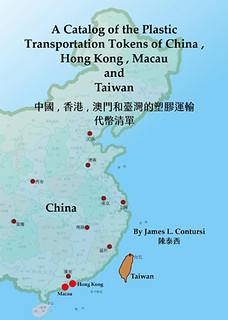 A Catalog of the Plastic Transportation Tokens of China, Hong Kong, Macau and Taiwan, up to and including 2023, is hot off the press.
A Catalog of the Plastic Transportation Tokens of China, Hong Kong, Macau and Taiwan, up to and including 2023, is hot off the press.
This is the first time such a detailed undertaking of these tokens has been published, and it covers all modes of transportation: bus, ferry, metro and rail.
This work lists more than 230 pattern/prototype, test, regular-issue, commemorative, souvenir, advertising, and travel-pass tokens.
The introduction is in English, but all token legends in Chinese are translated into English and supplemented with pinyin transliteration.
Each token is assigned an individual catalog number, which encodes its geographical origin (country, province, county and/or city), type, and chronology. Typically, at least one example of each type is pictured in color.
Also, each token is assigned two of four rarity ratings: C (common), U (uncommon), S (scarce) and R (rare). One of these grades indicates the token's availability at its place of issue; the other, on a worldwide platform, outside its place of issue. This novel approach allows collectors to understand better a particular token's overall supply and value.
Specifics:
Size: 15cm x 21cm
Pages: 102, color photos
ISBN: 0-9770216-3-7
To order, or for more information, contact author at: mnbkmn@hotmail.com.
Jim adds:
"The book is soft cover. The price will be $22 for E-Sylum readers; or $25 if purchased on eBay. Shipping additional, about $8 to $10, depending on destination."
MAX JACOB HUMBERT (1929-2024)
Tom Mulvaney notified me of the passing of Max Humbert, one of the founders of Paramount International Coin Corporation. Thanks. Born January 25, 1929, in North Canton, Ohio, he passed at the age of 95 February 29, 2024 in Rockwood, Tennessee.
Here's an introduction from Tom followed by an article about Max from The Paramount Journal (Volume 1, No. 2, June 1973), and more. -Editor
Tom writes:
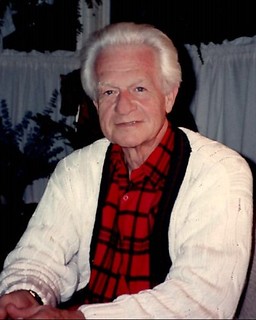 "Before getting into the coin business, Max was a freight agent with the B&O Railroad in Dayton, OH. He was one of the founders of Paramount International Coin Corporation in Dayton/Englewood, Ohio along with Jim Kelly and former Ohio governor, Michael DiSalle around 1964. Soon after, Q. David Bowers briefly was a part of the firm, too. When I was hired at Paramount in January, 1973, Max was the President of the company. I remember Max well. I am sure many
"Before getting into the coin business, Max was a freight agent with the B&O Railroad in Dayton, OH. He was one of the founders of Paramount International Coin Corporation in Dayton/Englewood, Ohio along with Jim Kelly and former Ohio governor, Michael DiSalle around 1964. Soon after, Q. David Bowers briefly was a part of the firm, too. When I was hired at Paramount in January, 1973, Max was the President of the company. I remember Max well. I am sure many OLD Timers
like me do, too.
During the mid-late 1980's, after I left Paramount, Max faded into numismatic history. His obituary mentions nothing of his major contributions to the numismatic arena. He WAS a major figure in the business and was very knowledgeable, especially in the rare gold market. Paramount is long gone and only a few of us remain who were there during its heyday in the 1970's."
"We have just scratched the surface of numismatics," said Max J. Humbert, Chairman of the Board and President of Paramount International Coin Corporation during a recent interview.
It is this conviction and dogged determination to seek out new ways of serving collectors and the hobby that have skyrocketed Max to the head of one of the largest numismatic companies in the world.
With no previous experience in numismatics, Max Humbert entered the coin field "through the back door," so to speak, when early in 1959 he started a small part-time business, Gradually, however, coin collecting worked its way into Max's everyday life and scarcely without realizing it, Max had found himself a hobby.
Somewhere along the way the idea of a Presidential Medal took seed, and in 1960 he and Frank Darner founded Presidential Art Medals, a company which developed and flourished into a successful venture of its own. During his tenure as Vice President of this company, Max had the privilege of meeting with four Presidents or ex-Presidents, Truman, Eisenhower, Kennedy and Johnson, for purposes of developing these medals. It is a matter of history that each of these great men gave their support and approval to the medals and their interest in the series is believed to be unique in the annals of collecting. President Kennedy personally passed out his medals as mementoes and the Eisenhower medals were used as gifts for the guests at the party for "Ikes" 73rd birthday.
In 1963, ever aware of the collector and his needs, Max envisioned a publicly owned numismatic company which would provide a wide range of services for the collector. It would be a company that would offer an outstanding selection of rare coins as well as high quality auctions. Even more importantly, Max saw the need for a central place where collectors could order modern issue coins. This would save the average collector from the difficulties and expense associated with having to send to each country separately for the modern issue proof sets and commemorative coins he needed for his collection. This vision ultimately led to Paramount's highly successful World Proof Set Program wherein Paramount is the sole numismatic agent for numerous foreign governments.
Following up on his idea of a publicly owned "super company", Max collaborated with his two good friends, James Kelly, world famous numismatist, and Michael V. DiSalle, former Governor of Ohio. From this alliance, Paramount was born. Its securities were registered with the Securities and Exchange Commission in June, 1964, and thus Paramount became the first publicly owned numismatic firm. From this modest beginning, but with a wealth of vision behind it, Paramount has emerged as one of the leading firms in the world. It maintains a rare coin inventory in excess of 3 million dollars, and conducts several major auctions annually. Paramount has had the distinction of being awarded the prestigious American Numismatic Association Auction a record of eight times. And, Max's pet project, the World Proof Set Program, has developed into the most exciting and fastest growing segment of numismatics, attracting thousands of new collectors to the hobby each year. The program began in 1966 when Panama became the first country represented by Paramount. Since that time, nearly half a million proof sets from a dozen countries have been sold to enthusiastic collectors and the interest in modern issues has escalated by leaps and bounds.
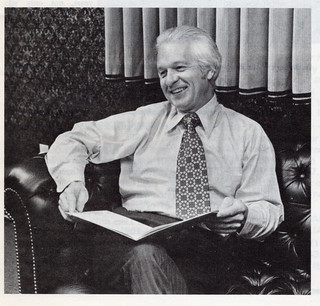 Following the death of James Kelly in 1969, Max picked up the reins of the presidency, and under his tutelage Paramount has steadily grown to an efficient organization of nearly one hundred employees. Today a big part of that multi-million dollar operation is computerized, and the company continues to seek out new ways to serve the collectors that constitute the heart of an increasingly popular hobby. With the constantly expanding World Proof Set program, Max has become a real "world traveler," meeting with various heads of state in the furtherance of this program. As a result he has little leisure time, and the days spent in his office often stretch into ten and twelve hours. Golf, once a full-fledged hobby, is now a "sometime thing" and his trips to the greens grow farther and farther apart. However it takes more than work to pry Max from the TV set on fall Sunday afternoons when he relaxes and watches professional football games. Paramount's president firmly believes that the growth of the coin hobby is really just beginning and he recognizes at once that the greatest problems confronting it are grading and pricing standards, both of which,
in reality, go hand-in-hand in numismatics.
Following the death of James Kelly in 1969, Max picked up the reins of the presidency, and under his tutelage Paramount has steadily grown to an efficient organization of nearly one hundred employees. Today a big part of that multi-million dollar operation is computerized, and the company continues to seek out new ways to serve the collectors that constitute the heart of an increasingly popular hobby. With the constantly expanding World Proof Set program, Max has become a real "world traveler," meeting with various heads of state in the furtherance of this program. As a result he has little leisure time, and the days spent in his office often stretch into ten and twelve hours. Golf, once a full-fledged hobby, is now a "sometime thing" and his trips to the greens grow farther and farther apart. However it takes more than work to pry Max from the TV set on fall Sunday afternoons when he relaxes and watches professional football games. Paramount's president firmly believes that the growth of the coin hobby is really just beginning and he recognizes at once that the greatest problems confronting it are grading and pricing standards, both of which,
in reality, go hand-in-hand in numismatics.
He concedes that grading has come a long way toward standardization, but he also knows that wherever the human element is involved, there will be differences of opinion. But this he looks on as really part of the fun of the game. As for pricing, he is adamantly opposed to enforced regulations because he feels that they would eliminate some of the pleasure of the hobby itself. He noted that "one of the thrills of numismatics is obtaining an outstanding bargain or even just a good buy, and this is true for both dealers and collectors". This "thrill" would be lost with price regulations. Max puts great stock in Paramount's responsibility to the collector and the hobby, and believes this sense of responsibility is what sets Paramount apart from other companies. In his own words: "Paramount's position has been, and always will be, such that we will look upon the collector as our greatest permanent asset. We treasure our Paramount customers and view each transaction as a part of a permanent relationship. Also, in looking ahead, I see a broad opportunity for Paramount to serve collectors in other parts of the world. . . as well as in the United States."
This prediction seems already well underway, as Paramount now has subsidiary companies in Jamaica and the Bahamas, and plans are going forward for new marketing facilities in the United Kingdom and Europe. As a result of the rapid growth of the company, Paramount has outgrown its present physical facility and so under Max's guidance, Paramount is about to build a brand new home, a magnificent building with over 20,000 square feet of floor space. There will be an excellent over-the-counter facility, with conference rooms and private sales rooms. The building will have the most up-to-date security system available, complete with closed circuit TV. Shipping and storage facilities, and a huge 5,000 square foot vault will probably be the largest in numismatics. Max Humbert is a dedicated man who is determined to see that numismatics maintains it prestigious position in today's world of hobbies; and that every collector — novice or expert — will come to look to Paramount for complete honesty, integrity and the right answers to his coin needs, questions, and even his problems.
Here's a view into the booming market from Max's August 1973 "from the President's desk" column in The Paramount Journal. -Editor
As an illustration of the rapid growth of interest among collectors, our mailing list was a modest 6,000 to 8,000 in 1967 and currently approaches 200,000! These are active customers that have purchased coins during the past 12 months. We have broken up approximately 30 roll sets of brilliant uncirculated Franklin halves and 50 roll sets of brilliant uncirculated silver war nickels and sold them as individual sets during the past year. It is virtually impossible to replace these and chances are practically nil that these coins will be placed back into the market as roll sets again. While these coins cannot be considered rare by current standards, this fact graphically points out how coins are being widely dispersed today and in getting into many different collectors' hands rather than into just the group of speculators.
True rarities are finally being recognized and no doubt we are in a new era in numismatics. Collectors are also recognizing that there is generally a huge difference in availability and rarity between the so called average uncirculated coin and the choice or gem coins. They are also willing to pay a correspondingly large difference in price. Therefore, coins that brought a mere $1,000 several years ago, are currently bringing $25,000 to $50,000. It seems like a phenomenal thing, but when you analyze current prices in comparison to the rarity of the coins, there is sufficient reason to believe they will continue to go higher. I believe the growth is just beginning and that during the next few years will broaden beyond what most people in the business could ever imagine.
Mark Auerbach writes:
"Max was a great ambassador to foreign governments in securing exclusive distribution contracts for NCLT coinage. Paramount even had a hand in designing some interesting foreign coinage. Max had substantial political connections, as in co-founding member, Michael DiSalle, former governor of Ohio. Max was very diverse, interesting and always a gentleman!"
Jim Halperin writes:
"I barely knew Max, but my friend David Akers always had extremely nice things to say about him."
Lorne LaVertu writes:
"I was in Max's company only six times in the year I was at Paramount (Sept'74-July'75), usually at receptions for upcoming auctions and, of course, at the huge reception on our purchase of the Judd 1776 (now Judd 205) gold $20 pattern as part of the Wilkison Gold Pattern acquisition.
"Max was more the political/marketing strategist. We, meaning most of the rank and file staff, interacted primarily with Ron Howard (Our Buyer); Ray Merena (Operations Mgr.); and Dave Akers (Our VP), all of whom would provide insights into our purchases, and gave lectures on all aspects of the coin market, with emphasis on the gold purchases, especially the Wilkison Pattern purchase.
"He was good at marketing given we were considered the largest (sales wise) coin firm, and one of the top four coin firms (Bowers/Stacks/Superior/Paramount) throughout the 70's. That, in itself, says a lot."
Here's some information about the company's headquarters building. -Editor
Tom Mulvaney writes:
"Before the new building was built, Paramount's staff worked out of several leased spaces in Englewood. Max was the force behind having the building constructed. It opened in 1974 and was BIG news in the local area. For several years, Paramount was the largest employer in Englewood with 200 employees at its peak.
"For me, it was a really great place to work for nearly a decade before "the wheels fell off" in the early 80's due to a very depressed coin market and other well publicized news on tax problems the company had."
Groundbreaking ceremonies for the new Paramount 50,000 square foot corporate headquarters in August of 1973. Left to right: Carl Boltz, Mayor of Englewood, OH, Vincent Donise, Max Humbert. Photo by Tom Mulvaney
Tom adds:
"I believe Vincent Donise was an investor in Paramount International Coin Corp., which was a publicly held company."
A special limited edition postal cover commemorating the event which Max signed. Only 6 were made. Photo by Tom Mulvaney
Tom adds:
"I believe Mark Auerbach was responsible for having these made. This is a scan of mine. I believe these were given to the Company officers, Mark and me."
Mark Auerbach started the stamp division at Paramount, and he confirmed that he produced these covers. Mark also kindly provided scans of some issues of The Paramount Journal not already digitized at the Newman Portal. Thanks, everyone. Important numismatic history. Here's a final note from Humbert's obituary. -Editor
Mr. Max Jacob Humbert, age 95, a resident of Rockwood, Tennessee went home to be with the Lord and to be rejoined with his beloved wife, Shelia on Thursday, February 29, 2024, from his home in Rockwood with his family by his side. He was born January 25, 1929, in North Canton, Ohio. Mr. Humbert lived a very full, accomplished, and interesting life, but became a Christian in 1991, and it was this moment and his life since that he most cherished and wished to be remembered. According to himself, his success was in Jesus Christ. He leaves a legacy as a God loving, faithful Christian man, who loved Christ and was always giving to the work of the Lord and helping those in need. He was preceded in death by his parents, Jacob & Marjorie Humbert; his wife who was the Love of his life and his True Love Story
, Shelia Humbert; daughter, Selena Marbarker; son, Jeff Humbert; and brothers, Jack Humbert, Don Humbert, and Bob Humbert.
To read the complete obituary, see:
Max Jacob Humbert
(https://www.evansmortuary.biz/obituaries/max-humbert)
RALPH JAMES WINTER (1944-2024)
Original Hobo Nickel Society Membership Director Kelsey Forde shared this news in an email to members April 10, 2024. -Editor
"We have some sad news to share... Long-time member, Hobo Nickel Enthusiast, Bo-Tales Editor, and so much more, Ralph Winter, caught the westbound train
and lost his battle with cancer on March 16, 2024.
"Ralph was a huge asset to the OHNS and Numismatic Communities. Ralph received numerous awards throughout the years for his contributions, including recognition from the American Numismatic Association. He will be greatly missed.
"The Summer 2024 issue of Bo-Tales will feature memories and stories about Ralph from those who knew him personally and through his articles. Please send memories, articles, and content to Carol BoFrog
Bastable at
chevybassdad01@verizon.net by April 30th, 2024 to have your memory included in the Summer 2024 Bo-Tales issue."
Sorry to hear this news. We never met in person, but I was in touch with Ralph regularly over the years and he was always happy to share news and content with E-Sylum readers. He will indeed be missed. -Editor
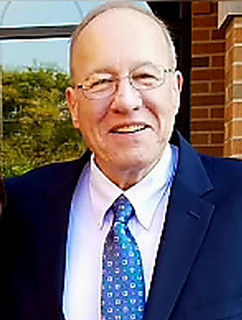 Ralph James Winter, aged 79, passed away on March 16, 2024. He was a beloved husband, father, grandfather, and friend who will be deeply missed by all who knew him.
Ralph James Winter, aged 79, passed away on March 16, 2024. He was a beloved husband, father, grandfather, and friend who will be deeply missed by all who knew him.
Ralph was born on August 14, 1944 in Cleveland, OH, then spent his formative years in Orange Township, OH. He went on to attend Purdue University, playing trombone in the marching band and serving in the Theta Xi fraternity. He earned his BS in Industrial Management in 1967. In 1968 he married the love of his life, Ginger Winter (Dodge). He was then drafted into the army and served a tour in Vietnam from 1970-1971.
In 1974 he earned his MBA from Eastern Michigan University. Ralph was hired into General Motors Co. where he worked in the Hydramatic division from 1968-2008. Throughout his career, he was known for his hard work, dedication, and passion for helping others.
Ralph and Ginger started their life together living in Ann Arbor, MI, then moved to their dream home in 1977 in Saline, MI where they lived for 41 years. Ralph enjoyed caring for his half acre garden, taking care of all of the ducks on the pond, and creating a fun outdoor environment for his kids.
Ralph was a devoted husband and father. He supported his wife, Ginger, in her Mary Kay career and was always supportive of his daughters, Melissa and Trisha, in everything they did. He was also active in their church, First Presbyterian church of Ann Arbor where he served as a deacon. In his later years, he took extreme pride in his six granddaughters and was an active part of their lives.
In his free time, Ralph enjoyed collecting hobo nickels and served as the Editor of the Original Hobo Nickel Society publication BoTales for over 15 years. He received multiple awards from the American Numismatic Association for outstanding specialty numismatic publication. He also received the Glenn Smedley Memorial Award in recognition of his outstanding and dedicated service to the numismatic hobby. Ralph was always eager to share his knowledge and enthusiasm for hobo nickels with others.
OHNS Treasurer Sandy Pearl adds:
"Ralph Winter received an ANA Presidential Award posthumously. The award was presented by ANA President Tom Uram to Ralph's wife and girls at a Huron Valley Coin Club meeting."
To read the complete obituary, see:
Ralph James Winter
(https://everloved.com/life-of/ralph-winter/obituary/)
For more information on the Original Hobo Nickel Society, see:
http://www.hobonickels.org/
THE BOOK BAZARRE
EDWARD LEE CRAIG (1946-2024)
Maryland Numismatic Society Vice President Bill Miller writes:
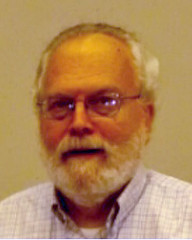 "The Maryland Token and Medal Society (MD TAMS) has lost its long-time president and guiding light, Edward Craig. Ed was a 35 year member of our organization and president for over 25 years. Much of the success of MD TAMS during this time period was due to Ed. He presided over meetings and swap-meets, wrote articles, and aided in the publishing of MD TAMS reference books.
"The Maryland Token and Medal Society (MD TAMS) has lost its long-time president and guiding light, Edward Craig. Ed was a 35 year member of our organization and president for over 25 years. Much of the success of MD TAMS during this time period was due to Ed. He presided over meetings and swap-meets, wrote articles, and aided in the publishing of MD TAMS reference books.
"A member of several collecting organizations, Ed was a past-president of the Maryland State Numismatic Association (MSNA) and for many years could be seen helping behind the desk of the Whitman Coin Expos held in Baltimore. He was a member of the national Token and Medal Society (TAMS) and the National Token Collectors Association (NTCA) as well. While Ed's primary collecting interest was Maryland tokens and medals, he also was a well known collector of Alaska and Hawaii exonumia. For many years Ed traveled to Hawaii to visit friends and fellow collectors.
"In a time of declining membership Ed was the glue that helped keep our club together; his loss is enormous. He was a good friend who will be missed not only by MD TAMS, but by many in the collecting community."
MD TAMS journal editor Jane Sears writes:
"I'm having a Memorial Section in our Summer journal. Anyone who would like to add their comments, please send your words to me at marysears@comcast.net . My deadline is May 15."
Sorry to hear this news. E-Sylum Feature Writer and American Numismatic Biographies author Pete Smith submitted this additional information on Ed Craig. Thanks! -Editor
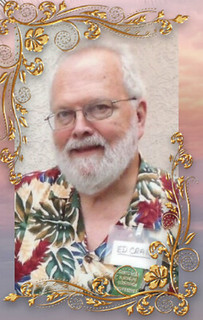 The first time I recall speaking to Ed Craig was at the Baltimore ANA show in 2008. He was the general
chairman. I inquired about some other token collectors I knew from Baltimore. At the time, MD-TAMS
was giving a one-year free membership to ANA members who signed up at the show. I was impressed
with the catalogs of Maryland tokens that had been published by MD-TAMS.
The first time I recall speaking to Ed Craig was at the Baltimore ANA show in 2008. He was the general
chairman. I inquired about some other token collectors I knew from Baltimore. At the time, MD-TAMS
was giving a one-year free membership to ANA members who signed up at the show. I was impressed
with the catalogs of Maryland tokens that had been published by MD-TAMS.
I attended the National Token Collectors Association (NTCA) show in Fargo in 2010. The first night I saw Ed sitting in the lobby, I think we talked for a couple of hours. I recall that he had an interest in pickers and packers tokens. The next morning my roommate and I walked into breakfast and saw Ed sitting alone. We joined him and had another good conversation. I attended several other shows in Baltimore but I don't recall other conversations with Ed.
Edward Lee Craig was born on October 25, 1946. His parents were Edward Callow Craig (1920-2000) and Eleanor Evelyn Arnick Craig (1923-2019). His father was an engineer with Bethlehem Steel.
He graduated from Loyola College and served with the Maryland National Guard, Other than a posting in Hawaii 1981 to 1984, he lived in Dundalk, Maryland, most of his life. He had the same address in 2000 as he had in 1950. It appears that he bought his parents' house in 1993.
In 1972 there was an announcement of the engagement of Antoinette V. Chiazza to Edward Lee Craig. She married someone else eight months later in 1973. It is believed that Edward Craig never married.
As Edward Lee Craig, he joined the ANA in 1989. He later became life member LM 6091.
White living in Hawaii. Craig developed an interest in school lunch tokens. Living in Maryland fueled his interest in pickers, packers and canners tokens.
Ed Craig was a regular volunteer at the Baltimore shows. He became the president of Maryland Token and Medal Society (MD-TAMS) in June 1996, following the resignation of Greg Ruby. His leadership has kept MD-TAMS going through a period of declining membership. He wrote articles for the journal resurrecting a project to catalog Maryland wooden nickels and published regular updates. Craig is a strong believer in documenting exonumia as it is produced. An example is a catalog of Maryland food stamp change tokens. Craig mentioned in a 2008 interview that the club had produced twenty listings by then.
He was president of the Baltimore Coin Club and the president of the Maryland State Numismatic Association (MSNA) in 2003-2005. Craig served as executive director and bourse chairman for the Baltimore Area Numismatic Coalition 1997 to 2007. He was also an active member of CWTS (LM), EAC (LM), NTCA, TAMS (LM) and TEC.
Craig retired from employment with the U. S. Defense Department in 2008 after 40 years of service. When asked about his work, friends commented that he never talked about it.
For the 2008 ANA Convention, Craig produced a 39 mm brass personal medal. It identified him as a "MARYLAND AND HAWAII EXONUMIA COLLECTOR. He also produced elongated coins for the occasion.
He returned to Hawaii for a visit in 2016 for the 75 th (Diamond) Anniversary of the attack on Pearl Harbor. Craig commissioned two medals to commemorate the occasion. One obverse has King Kamehameha III based on the 1847 Hawaii cent. The other obverse features a fantasy 1891 dollar struck in England by Pinches & Co.
The common reverse mentions the USCGC Taney Baltimore – Maryland and Last Ship afloat that saw
action in Hawaii 7 December 1941.
The medals were struck in red bronze, yellow brass and white silver
plate.
Edward Craig had been ill and died on April 3, 2024.
Does anyone have more to share about Ed? -Editor
To read his online obituary, see:
Edward L. Craig
(https://www.ruckfuneralhomes.com/obituary/edward-craig)
JOHN EDWARD GUSMANO (1963-2024)
An article in the January-March 2024 issue of TEC News from The Elongated Collectors Inc. profiles elongated coin engraver John Gusmano, who died last month. With permission, we're republishing it here. Sorry to hear this news. -Editor
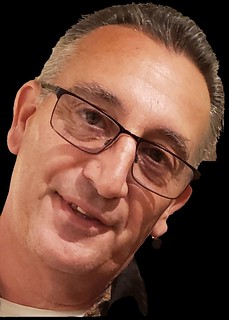 Prolific elongated coin engraver John Gusmano, TEC #4513, died March 6, 2024, in Grand
Rapids, Michigan,
Prolific elongated coin engraver John Gusmano, TEC #4513, died March 6, 2024, in Grand
Rapids, Michigan, peacefully and with a heart full of love,
according to his family, following
an eight-month-long battle with lung cancer. He was 60.
The world of elongateds has lost a true talent,
said TEC president, Tyler Tyson, TEC #3262.
Those that worked with John understand the loss.
Among those is Michelle Kilcoyne, TEC #5096, graphic designer, engraver, owner of The
Penny Depot, and daughter-in-law of James and Carol Kilcoyne, TEC #1887 and #3176.
John's absence will be deeply felt; he leaves an indelible mark on the elongated penny world,
she said.
Graphic designer and TEC vice president, Paul Conner, TEC #3951, echoed that sentiment,
saying, When my phone rang and I heard [of John's death], I just packed my stuff up and went
home immediately.
John worked in the tool and die graphics industry for over 40 years, including time with Tenibac-Graphion Inc. He was my friend as well as a business associate, having done the majority of my
die work for almost 20 years,
said TEC treasurer and immediate past president, Cindy
Calhoun, TEC #3467-LM. Years ago, my husband, Ed, my mom, and I were on a RV trip and
stopped to visit John. He gave us a tour of the facility, showed us how die rings were etched, and
presented Ed and me with an engraved bottle of champagne for our 25th wedding anniversary.
When Tenibac-Graphion was sold in 2018, John started his own business, C&J Engraving, and
secured his place in the history of the hobby. Although most collectors never met John, they
likely possess dozens, if not hundreds, of elongated coins rolled from dies he engraved. Based
on his 12 C&J invoice books, which started in 2018, he likely did more than 3,000 elongated
engravings,
said Cindy.
Over the years, what was supposed to be a quick call to check on the status of my engravings
would often turn into an extended conversation,
said Tyler. I truly believed I had my finger on
the pulse of the elongated coin world, but John knew our world on a level that was much deeper
than anyone else.
John devoted his time to doing dies for others,
said Cindy. When I was helping his family
return die rings to their owners, I was surprised that we found only three die rings with images he
did for himself. Everything else had been work for others.
Paul added, I had some fundraiser jobs I worked on where he would either do the etching for
free or at a reduced cost to help with the efforts.
Michelle recalled, Back in the 1990s, I heard stories about John and how great it was to work
with him. In the early 2000s, I had the opportunity to send him artwork. He was always
incredibly helpful when Carol and I first started with CorelDRAW graphics software. John
generously shared tips to enhance my designs over the years. I enjoyed experimenting with new
ideas, even if John initially doubted their feasibility. However, more often than not, the outcomes
proved successful, and eventually, he began to engrave my designs without question.
He did hundreds of etchings for me,
said Paul, and came to me for artwork on many projects
that he was working on. He was always very nice and usually straight to the point. I would
always ask if he saw anything that might not etch well and he would let me know if he saw
anything.
Even when I started engraving my own dies,
Michelle recalled, John and I continued to
collaborate frequently. If he had intricate designs that required engraving, he would send them to
me. Despite our both being engravers for the past several years, we maintained our
communication and partnership. I never viewed him as competition; rather, he was a
compassionate individual who excelled as a chemical engraver. He was the finest chemical
engraver in the industry, in my opinion.
Known as a calm man with wide-ranging passions, John's cool, easy going demeanor made any
issue I had, easy to resolve,
said Tyler. Our conversations would veer off into numerous things
besides elongates; he was very easy to talk to,
said Tyler.
John was not only a skilled engraver but also a wonderful person with whom I shared many
conversations about life,
added Michelle.
Among John's many passions was music. When he turned 40, he taught himself how to play
guitar. He loved to jam with his band, RCG. He was always positive, extremely generous and
immensely wise – a master in psychology without the degree,
as his daughter, Jessica Urick,
put it.
John Edward Gusmano was born in Detroit, Michigan, on May 10, 1963, to Audrey Lee and Marion Anthony (Gus) Gusmano. John was the first born, folowed by his sisters, Eleanor and Katherine. After graduating from high school in Mount Clemens, Michigan, he moved to Key Marathon. He and his former wife, Karen, had two children. In 2021, John returned to Michigan and settled in Grand Rapids, where he met his fiancé.
John is survived by his fiancé, Linda; two children, John Anthony (JoAnna) Gusmano and Jessica (William) Urick; two grandchildren, Joshua and Joslyn; five step-grandchildren and nine step-great grandchildren.
As John wished, his closest friends and family will celebrate his life privately over the summer,
his favorite season. Meanwhile, his family has posted a memorial video on YouTube. In the
video, while on vacation in Nicaragua, John remarked, the hardest thing I did [today] was grind
coffee beans and decide what swimsuit to put on.
He wisely advised the viewer to go to your
happy place. I'm going to come right here. Grinding coffee would be my happy place.
We encourage you to watch the YouTube video put together by Jessica: Rest in paradise, John
Edward Gusmano,
found at
https://www.youtube.com/watch?v=18Km7HZidUM
For more information on The Elongated Collectors Inc., see:
https://tecnews.org/
NNP ADDS TO CONGRESSIONAL REPORT SERIES
The latest additions to the Newman Numismatic Portal are Congressional Reports with numismatic content. Project Coordinator Len Augsburger provided the following report. -Editor
Newman Portal Adds to Congressional Report Series
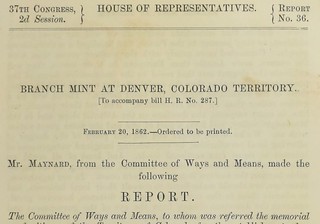 Courtesy of Paul Hybert, we have added to Newman Portal a large group of U.S. congressional reports with numismatic content. This series now includes 375 items, and we acknowledge also Dan Hamelberg, who has previously contributed to this group. As Congress exercises its authority over the nation's coinage, this series documents an important part of our numismatic history. Congress authorizes new coins, personal medals, and controls other aspects of coinage, such as the restoration of Mint marks in 1967.
Courtesy of Paul Hybert, we have added to Newman Portal a large group of U.S. congressional reports with numismatic content. This series now includes 375 items, and we acknowledge also Dan Hamelberg, who has previously contributed to this group. As Congress exercises its authority over the nation's coinage, this series documents an important part of our numismatic history. Congress authorizes new coins, personal medals, and controls other aspects of coinage, such as the restoration of Mint marks in 1967.
From a bibliophilic perspective, these reports typically come disbound. The Congressional serial set, which documents activities of the House and Senate, is a massive record, on the order 20,000 printed volumes. As institutions deaccession these volumes over time, numismatic sections are extracted and occasionally trade in the numismatic literature marketplace. With electronic access to the Congressional serial set now available via ProQuest subscription, institutions have less of a need to maintain hardcopy sets, not to mention the cost of maintaining a facility to house the material.
Image: Congressional report from 1862, related to a proposal to launch a Branch Mint in Denver
Thanks, everyone! This is a great resource for researchers. -Editor
Link to U.S Congressional reports on Newman Portal:
https://nnp.wustl.edu/library/publisherdetail/512550
Link to Mint Marks,
S. 1008, a 1967 bill to restore Mint marks on U.S. coinage:
https://nnp.wustl.edu/library/book/612162
VIDEO: COINAGE OF THE ENGLISH CIVIL WAR
The David Lisot Video Library on the Newman Numismatic Portal can be found at:
https://nnp.wustl.edu/library/multimediadetail/522852
We highlight one of his videos each week in The E-Sylum. Here's one from 2005 with Arthur M. Fitts speaking about the coinage of Charles I and the English Civil War. -Editor
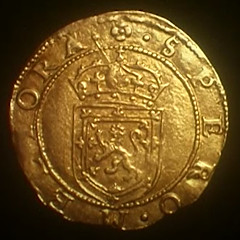 The English Civil War of 1642-49 pitted King Charles I against Parliament, which controlled the Royal Mint in London that continued to strike gold and silver coinage. See the coin issues of the Royalist's throughout the land that rallied to help the king's cause. This presentation includes: Background of King Charles I who ruled from 1625 to 1649 Examples of coinage that show Initial marks, privy marks, denominations, clothing styles, equestrian figures and interesting legends Explanation of the belief in the divine right of kings Uses of Spanish silver The different quality of coins produced Examples of coinage struck by the Royalists forces until the capture and execution of Charles.
The English Civil War of 1642-49 pitted King Charles I against Parliament, which controlled the Royal Mint in London that continued to strike gold and silver coinage. See the coin issues of the Royalist's throughout the land that rallied to help the king's cause. This presentation includes: Background of King Charles I who ruled from 1625 to 1649 Examples of coinage that show Initial marks, privy marks, denominations, clothing styles, equestrian figures and interesting legends Explanation of the belief in the divine right of kings Uses of Spanish silver The different quality of coins produced Examples of coinage struck by the Royalists forces until the capture and execution of Charles.
Speaker(s): Arthur M. Fitts, III.
To watch the complete video, see:
Coinage of Charles I and the English Civil War
(https://nnp.wustl.edu/library/book/557178)
NOTES FROM E-SYLUM READERS: APRIL 14, 2024
More on Maundy Money Terms
David Pickup writes:
"Are recipients of Maundy money maundees
?!"
Ken Berger writes:
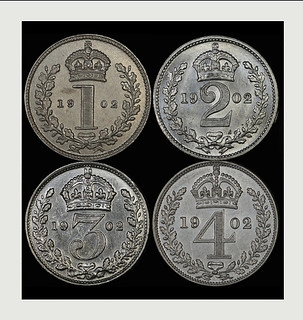 "With respect to Michael T. Shutterly's comments regarding the derivation of the word Maundy, I believe that some clarification is needed. He refers to Vulgate Latin as if it is different from regular Latin. Except for one very minor structural difference, Vulgate Latin refers basically to how it was pronounced compared to Classical Latin. (For example, the word Caesar would be pronounced as Kaiser in Classical Latin & Chaysar in Vulgate Latin.)
"With respect to Michael T. Shutterly's comments regarding the derivation of the word Maundy, I believe that some clarification is needed. He refers to Vulgate Latin as if it is different from regular Latin. Except for one very minor structural difference, Vulgate Latin refers basically to how it was pronounced compared to Classical Latin. (For example, the word Caesar would be pronounced as Kaiser in Classical Latin & Chaysar in Vulgate Latin.)
"Vulgate Latin was the Latin spoken by the common masses of people, whereas Classical Latin was spoken by the upper classes. For obvious reasons, the Latin used by the Catholic Church was Vulgate Latin. Shutterly's example of novum mandatum is written in Latin, not Vulgate Latin nor Classical Latin, just Latin.
"P.S. This difference in pronunciation caused me some problems in my high school Latin 3 class. I had been taught Classical pronunciation whereas my teacher was using Vulgate pronunciation. Since my pronunciation was technically not wrong, my teacher had to accept it."
Thanks, everyone. -Editor
To read the earlier E-Sylum articles, see:
MAUNDY COINAGE THEN AND NOW
(https://www.coinbooks.org/v27/esylum_v27n13a24.html)
NOTES FROM E-SYLUM READERS: APRIL 7, 2024 : Vocabulary: Maundy
(https://www.coinbooks.org/v27/esylum_v27n14a10.html)
NOTES FROM E-SYLUM READERS: APRIL 7, 2024 : Vocabulary: Giftees and Uncirculated Medals
(https://www.coinbooks.org/v27/esylum_v27n14a10.html)
More on Bernard Rome
Tom Caldwell of
Northeast Numismatics writes:
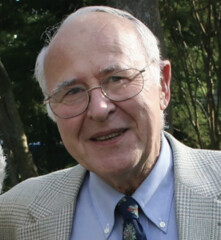 "As mentioned Bernard Rome was an avid entrepreneur, a politician, and an innovator always looking for new ideas and finding new business ideas to work on. Bernie pretty much started off-track betting in the state of New York in 1978 before his Teletrade coin days. In 1986 or 1987 I met Bernie at the annual International show at the World Trade Center in NYC. Yes, the WTC that we all know the fate of a decade and a half later, that's where the show was held at the time. We hit it off right away and I was a regular consignor to his new business venture called Teletrade. Quickly this turned into something much bigger for a collaboration of Northeast and his new company.
"As mentioned Bernard Rome was an avid entrepreneur, a politician, and an innovator always looking for new ideas and finding new business ideas to work on. Bernie pretty much started off-track betting in the state of New York in 1978 before his Teletrade coin days. In 1986 or 1987 I met Bernie at the annual International show at the World Trade Center in NYC. Yes, the WTC that we all know the fate of a decade and a half later, that's where the show was held at the time. We hit it off right away and I was a regular consignor to his new business venture called Teletrade. Quickly this turned into something much bigger for a collaboration of Northeast and his new company.
"In order to make a splash in the industry Bernie proposed that in addition to Northeast consigning, we also sell the company large quantities of certified coins. We were selling around $100,000 worth of material on a weekly basis. We were working very close with tiny profit margins and Teletrade about broke even on Northeast purchases. This went on for a couple of years until the point came when he basically did not need us anymore. The industry, dealers and collectors caught on to the popularity and success of Teletrade and Northeast no longer made sales to the firm but did remain a consistent consignor for many years.
"It was always kind of comical that near the close of major shows in the late 80's thru mid 90's many dealers could be seen writing up inventory on Teletrade forms and handing them over to the staff and trying to be secretive about the process. For the most part dealers did not want to let it be known that this was a major sources of sales for them.
"Bernie being the businessman that he was, sold the company during the 90's not once but twice. The first time he retained some ownership and the second time he sold out entirely. Bernard Rome was an innovator in numismatics and will long be remembered."
Thanks - great hobby history. -Editor
To read the earlier E-Sylum article, see:
BERNARD ROME (1934-2024)
(https://www.coinbooks.org/v27/esylum_v27n14a04.html)
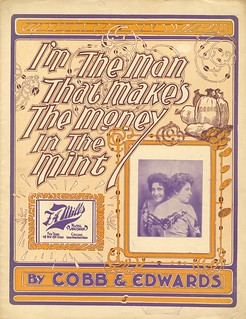 A Numismatic Earworm
A Numismatic Earworm
Jim Haas writes:
"I figured out the melody of "I'm the Man That Makes the Money In the Mint and it's now an earworm."
To read the earlier E-Sylum article, see:
WAYNE'S NUMISMATIC DIARY: APRIL 7, 2024
(https://www.coinbooks.org/v27/esylum_v27n14a20.html)
VOCABULARY TERM: PIERCING
Here's another entry from Dick Johnson's Encyclopedia of Coin and Medal Terminology. -Editor
Piercing. The process of perforating, punching or cutting out open areas in fully struck metal items as part of their intended design; openwork. Piercing is the most severe design element a coin or medal designer can employ in creating a design, it removes the opportunity for any design, texture, patina finish – anything! – in that area for both sides.
By creating "vacant space" or "negative mass" the designer consciously permits showthrough of any surface held behind the item; it also gives the greatest possible emphasis to the edge that has been outlined. Thus the outline shape of a pierced item often becomes more important than the design shown on either side. Such openwork adds exclusiveness to certain medallic designs, as with decorations of honor or orders, most of which have openwork and those of highest rank have the greatest amount of piercing and for the greatest visual distinction for pierced coins. Piercing is a technique for struck medals only, as cast medals have openwork created by the casting form.
Hand openwork. If it is not practical to construct expensive piercing tooling, as for extremely short runs of simple pierced designs, medallic items may be drilled and cut out by hand with a jigsaw (also called coping or jeweler's saw). This work is performed at a bench often by a chaser or as part of the chasing work.
Production run openwork. Production run piercing is accomplished with a piercing tool on a punch press. Special tooling is prepared for each openwork design, consisting of four parts: (1) a base plate in which holes are cut to allow scrap to fall through, (2) piercing die of hardened steel, cut with the exact design to be cut out, mounted on a base plate, (3) a nest to position the piece to be pierced, mounted to the die, and (4) a piercing punch made with projections of hardened steel (generally made of drill rod), and fastened to the upper part of the punch press.
The special tooling is constructed by a tool and diemaker to exacting specifications. The piercing must match perfectly the shape of the item and not cut into the design of either side.
The piercing punch is positioned (setup) in a punch press; its action can be described as follows: the item is placed in the nest fitting snugly into position, the press is actuated, forcing the piercing punch with its projections against the fully struck up medallic item of softened metal (lying next to the punching die), thus driving the projections through the item and the die, and punching out the piercing scrap which falls through the base plate.
Such piercing action, much like trimming, creates a burr on the side where the punch exists. This burr is removed by chasing or by abrasive blasting.
Multiple piercing. Very elaborate piercing designs infrequently call for multiple piercing when the open areas are so close together there is inadequate room for all tooling. This requires, therefore, two – or more – sets of piercing tooling, with a separate press run for piercing accomplished by each set of tooling.
To read the complete entry on the Newman Numismatic Portal, see:
Piercing
(https://nnp.wustl.edu/library/dictionarydetail/516487)
COPE COLLECTION OF BRITISH COINS OFFERED
In a joint sale in Zurich May 8, 2024, three firms are joining forces to offer the Cope Collection of Roman and British coinage. Here's the press release. -Editor
A spectacular Roman bronze coin depicting Emperor Hadrian addressing the legions of Britannia, and a magnificent silver Petition Crown
of King Charles II, are among the many highlights of the Cope Collection coming to the auction block on May 8 in Zurich, Switzerland under the auspices of three firms – Numismatica Ars Classica AG, Classical Numismatic Group LLC, and Numismatica Genevensis SA.
Assembled over 50 years by the clothes retailer and numismatist Geoffrey Cope of Leeds, UK, the Cope Collection comprises 170 ancient Roman bronze coins and more than 800 British issues. Condition was paramount: a significant number of the coins are considered the finest of their type. A second auction session featuring the rest of Cope's British holdings will take place in October 2024.
The celebrated bronze sestertius of Hadrian with a reverse depicting him addressing his legions stationed in Britain was on display for several years at the British Museum, and is easily the finest of fewer than five known examples of the type. Estimated at 300,000 Swiss francs ($328,000), the obverse of the coin presents a beautifully sculptured portrait of the emperor, who reigned AD 117 to 138.
The 170 ancient bronze coins in the Cope Collection are all of exceptional quality, including issues depicting both Roman emperors and empresses. Among the other Roman rulers depicted with almost photographic realism are Gaius Caligula,
his mother Agrippina Senior, Claudius, Nero, Vitellius, Vespasian, Trajan, Marcus Aurelius, Caracalla, and Macrinus.
Leading the lineup of British coins is the famous Petition Crown
of Charles II, the highest independently graded of 16 surviving examples. It is estimated SF 500,000 (around $545,000). Struck by celebrated medallist Thomas Simon, it was created in 1663 to ‘petition' Charles II to rehire Simon to his post as chief engraver at the Royal Mint.
Making use of new mechanical technology, a message engraved around the edge of the coin entreated the king to ‘compare this his tryall piece' with coins produced by his Dutch rivals for the position, the Roettier brothers. The third highest graded example sold for $800,000 at Heritage Auctions in January this year setting a new auction record for an English silver coin.
The Cope sales will also include the finest-known Henry VIII silver testoon, made circa 1544-45, with portrait based on the famous painting by Holbein, with an estimate of SF 40,000 / $43,000, and one of only three specimens in private hands of the famous Oxford ‘city view' Crown struck in 1644 for Charles I by Thomas Rawlins, estimated at SF 150,000 / $163,000.
David Guest, British coins specialist for CNG's London office, said: The sale of the Cope collection is one of the most significant dispersals of British coins in decades. Every era of coin production in the British Isles is represented in the collection.
Geoffrey Cope has written numerous articles about his numismatic passion. In one article posted on Coin Week, he explained: There are coins that create dreams when you see them and as you touch them, they speak to you ‘I am beautiful, love me, own me and look after me.' This is part of the obsession of a collector, the emotion, the vision of the individual who wishes to have in his collection a piece of history. The collector enjoys studying history to know what was his past then he will have a wider spectrum of the future.
The collection may be viewed online via http://www.copecollection.com, and private viewings may be arranged at the London offices of CNG (British coins until April 22) and NAC (Roman coins until April 19) prior to sale in Zurich.
During much of the 1970s and 80s, Geoffrey Cope ran Skopes, the men's tailoring business founded by his father in Leeds in 1948. His son Simon Cope, the vendor of the coin collection, now runs the firm.
GRANT REUNION BOOK AND MEDAL
Here's an offering for both numismatists and bibliophiles - a book containing a medal for the 1893 Ulysses S. Grant Reunion Dinner. I don't believe I've encountered this item before. -Editor
RARE 1893 Ulysses S Grant Reunion Inner Book with Important Struck Medal Republican Convention EX Libris William J Latta Penn Railroad President
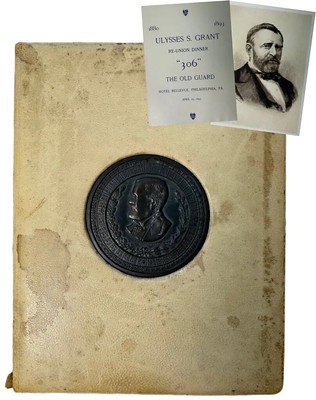 Commemorative book of the June 1880 Chicago Republican National Convention in which former Union General and then-sitting U.S. President Ulysses S. Grant was seeking an unprecedented 3rd consecutive term. Of the 14 men in contention for the Republican Nomination, the three strongest leading up to the convention were Grant, James G. Blaine, and John Sherman. After 35 ballots, there was still no decisive nominee; this is when Blain and Sherman switched their backing to a
Commemorative book of the June 1880 Chicago Republican National Convention in which former Union General and then-sitting U.S. President Ulysses S. Grant was seeking an unprecedented 3rd consecutive term. Of the 14 men in contention for the Republican Nomination, the three strongest leading up to the convention were Grant, James G. Blaine, and John Sherman. After 35 ballots, there was still no decisive nominee; this is when Blain and Sherman switched their backing to a dark horse
candidate in James Garfield. On the next ballot Garfield won the nomination with 399 votes, 93 more than the incumbent Grant. Garfield was declared the nominee the same day, and ultimately won the Presidency- a position he would hold for just over 6 months until his assassination at the hands of Charles J. Guiteau.
The event occurred only 16 years after the assassination of Abraham Lincoln, and was a catalyst for the formation of the Secret Service. This book is a re-union commemoration and delineates the selection process of Grant. Given by a Mr. Isaac M. Loughead to William J Latta, the Penn Railroad President, on July 7, 1893. Adorned on front and back with bronze medals, the first bearing a struck-bust of Grant, and the second inscribed Commemorative of the 36 Ballots of The Old Guard for Ulysses S. Grant for President. Republican National Convention Chicago June 1880.
Author Name: Unknown; likely multiple including Isaac M. Loughead.
Illustrator Name: Loughead & Co.
City of Publication: Philadelphia, PA
Date of Publication: April 25, 1893
Size of Book: 8 x 6.25 x 0.5 inches
Number of Pages: 31 Numbered Pages + Pre and Post Script
Condition of Cover and Pages, any Discoloration Of Binding and/or Spine: Staining to leather covers, very light moisture wrinkling on one or two interior pages, leather is very malleable and has only slight fraying on spine.
For more information, or to bid, see:
RARE 1893 Ulysses S Grant Reunion Inner Book with Important Struck Medal Republican Convention EX Li
(https://www.liveauctioneers.com/item/174976408_rare-1893-ulysses-s-grant-reunion-inner-book-with-important-struck-medal-republican-convention-ex-li)
THURSDAY LUNCH CLUB REPORT APRIL, 2024
Ray Williams of New Jersey submitted this report of the recent meeting of his Thursday lunch club. Thanks! -Editor
We were missing three friends today, Matt Virga, Wayne Shelby and Dan Knight. Meeting on a semi-regular basis, we should consider obtaining an official name for our lunches...a club name of some sort. You guys in Virginia have Nummis Nova. At lunch we share personal stories, numismatic items, personal research and numismatic comings and goings (along with aches and pains and medical issues - LOL). Typically we enjoy about two hours of fellowship. The lunch club members all have a common interest in colonial numismatics - coins, medals and paper.
Attendees of the April 4th Thursday Numismatic Lunch Club Clockwise: Bill Liatys, Mike Brooks, John Louis, Ray Williams, Roger Moore, Don Hartman, Leo Shane.
Counterfeit British Five Pounds printed by German concentration camp prisoners during WWII to undermine the British economy and also to fund some of their operations.
12 denier RF counterstamp
George Rules / British Tars Evasion Copper
Two Lion Dollars and a Half Rix Dollar
Very rare $20 May 1775 Continental Currency printed on marbled paper supplied by Franklin
1776 British gold Guinea
A denomination set of double-headed coins
Columbian Exposition elongated 1860 Seated Quarter
A sheet of South Carolina Bills
Admiral Vernon Medal
Interesting material! Great way to spend lunchtime. Thanks, everyone. -Editor
COINS OF JUSTINIAN THE GREAT
Mike Markowitz published a CoinWeek article on the coins of Justinian the Great. Here's an excerpt - see the complete article online. -Editor
Born to a peasant family in what is now North Macedonia about the year 482 CE, Justinian earned his epithet the Great
as a conqueror, a builder, an administrator, and, according to some contemporaries, a monster. The coinage of his long reign (527-565 CE) illustrates his extraordinary career.
Among the rarest collectible gold coins of Justinian are solidi minted at Alexandria in Egypt. These are distinguished by the mint mark ALEXAOB. The OB
stands for obryzum, a technical term for highly refined gold. Less than a dozen of these coins are known. In 2017, an example graded as Superb EF
brought $85,000 at auction.
An enigmatic and poorly understood group of gold coins are the lightweight
solidi, which first appear during the reign of Justinian and continue for about a century. These are often found outside the boundaries of the Empire, and they may have been intended for use in foreign trade, as diplomatic gifts, or as bribes to barbarian chieftains. The standard solidus weighed 24 siliquae. A siliqua was originally the weight of one seed of the carob tree (Ceratonia siliqua, about 0.2 grams). Large quantities of lightweight solidi were issued at standards of 20 and 22 siliquae–in effect, discounted by one sixth and one twelfth, respectively. Various mint marks were used to distinguish these issues, typically OBXX for the 20 and OB*+* for the 22 siliqua types.
Justinian's most spectacular coin no longer exists. This gold medallion of 36 solidi was 85 mm (3.35 inches) in diameter and would have weighed about 162 grams (5.2 troy ounces!) when it was struck.
Created as a presentation piece for high officials, it celebrates the reconquest of North Africa from the Vandals in 534. On the reverse, the winged figure of Victory leads a horse ridden by the emperor in military garb. The inscription SALVS ET GLORIA ROMANORVM hails the well-being and glory of the Romans.
The unique example was found in 1751 near Caesarea in Anatolia and acquired for the French royal collection. Stolen in 1831, it was melted down, but the British Museum preserved a cast in sulfur and high-fidelity gilded electrotype copies of the obverse and reverse were made. One of these museum replicas brought $16,000 in a 2022 U.S. auction.
To read the complete article, see:
Coins of Justinian the Great
(https://coinweek.com/justinian-the-great-ancient-byzantine-coins/)
ON COLLECTING BYZANTINE COINS
In his The Rational Optimist blog, Frank Robinson wrote about building a collection of Byzantine coins. Here's an excerpt - see the complete article online. -Editor
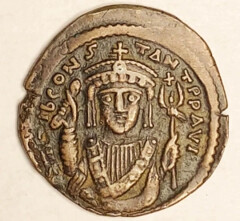 In my coin dealing business, customers like to sell me stuff. Couple years ago a guy drove up with a rented U-Haul fully packed with coins he said he'd been collecting since 1949.
In my coin dealing business, customers like to sell me stuff. Couple years ago a guy drove up with a rented U-Haul fully packed with coins he said he'd been collecting since 1949.
More recently another longtime customer sold me his ancient Greek coins. Turned out he'd specialized in the tiniest ones (like 3 to 8 millimeters). I gave him a price he was happy with. Had to work up a new technique to photograph such micro coins for my auctions.
Then he asked if I'd be interested in his Byzantine coins. Love them, said I.
I vividly remember, over 50 years ago, standing in a little shop, chatting with its owner over a tray of coins he'd bought. That's Byzantine,
I said, pointing to one. In the usual miserable condition.
Those words afterward reverberated with me. I actually knew nothing about Byzantine coins, except that they did tend to look pretty crappy. Now I wondered if it was possible to find and collect non-crappy ones. (For me quality is the name of the game in numismatics.) Soon enough a mail auction presented an opportunity, and so my Byzantine collection was launched.
The Byzantine Empire began as the Eastern part of the Roman one. After the West fell in 476 AD, the Byzantines flourished for further centuries, followed by a long decline, until 1453, when the Turks conquered their capital, Constantinople (today's Istanbul).
Byzantine gold coins are actually very common and usually very nice. It's the bronzes that are problematic, having been workhorses
of commerce, suffering much abuse — and were poorly made to begin with. Those are what I've collected. It's a highly interesting series, very varied, with many different types produced at numerous mints. The later ones tend to be scarcer, and even more quality-challenged.
But one can accomplish a lot in five decades, and I now have a pretty comprehensive collection, over 700 different coins (no duplicates), the quality ranging from decent to very nice. The difficult later series is particularly well represented since decades ago I bought the collection of a man who specialized in those...
Anyhow — my customer, who seemed a pretty sophisticated collector, sent me his 85 Byzantine coins, and I was keenly looking forward to this, hoping to add some goodies to my own holdings.
There were indeed some scarce and nice ones I didn't have. One a nummus (my spell checker wants to make this hummus
), the smallest value in the whole Byzantine repertoire, and rarely produced. This particular type, unusually with a facing bust of Justinian I (527-65 AD) and a lion on the reverse, I'd never even seen before, and it's in quite good condition.
Another was minted at Rome, while re-occupied by the Byzantines, who made rather few coins there. Wretched productions at that. This one again is much above average.
As I worked my way through the chronologically arranged box, I said to myself, this is the kind of collection that just might have a 1693.
A catalog number in Sear's definitive book, Byzantine Coins and Their Values. A Follis of Michael III (the Drunkard
) and Basil I from their brief joint reign, 866-67 AD (the depths of the Dark Ages
), with their facing busts on each side. A distinctive and rare major type that really should be in my collection, but I'd never managed to get one — and it had started to bug me. Like it had become a holy grail. Recently I'd put in what I thought was a strong bid in an obscure online auction, but lost out.
So as that number approached, I crossed my fingers...
To read the complete article, see:
A Byzantine Coin Lover's Frabjous Day
(https://rationaloptimist.wordpress.com/2024/04/03/a-byzantine-coin-lovers-frabjous-day/)
BYZANTINE SILVER BECAME MEDIEVAL COINS
University researchers have determined that melted-down Byzantine treasure provided the source of much of the silver coinage fueling Britain's medieval economic boom. Here's an excerpt from a University of Cambridge article. The original paper is linked here as well, along with a Smithsonian article forwarded by Larry Korchnak. Thanks. -Editor
Byzantine bullion fueled Europe's revolutionary adoption of silver coins in the mid-7th century, only to be overtaken by silver from a mine in Charlemagne's Francia a century later, new tests reveal. The findings could transform our understanding of Europe's economic and political development.
Between 660 and 750 AD, Anglo-Saxon England witnessed a profound revival in trade involving a dramatic surge in the use of silver coins, breaking from a reliance on gold. Around 7,000 of these silver 'pennies' have been recorded, a huge number, about as many as we have for the rest of the entire Anglo-Saxon period (5th century–1066).
For decades, experts have agonized over where the silver in these coins came from. Now a team of researchers from the Universities of Cambridge, Oxford and Vrije Universiteit Amsterdam have solved that mystery by analyzing the make-up of coins held by the Fitzwilliam Museum in Cambridge.
The journal Antiquity published the study. Co-author Rory Naismith, Professor of Early Medieval English History at the University of Cambridge, said, "There has been speculation that the silver came from Melle in France, or from an unknown mine, or that it could have been melted down church silver. But there wasn't any hard evidence to tell us one way or the other, so we set out to find it."
Previous research has tested coins and artifacts from the silver mine at Melle but Naismith and his colleagues turned their attention to less-studied coins which were minted in England, the Netherlands, Belgium and northern France.
Helpfully, Naismith had "a powerhouse of early medieval numismatic research" on his doorstep: The Fitzwilliam Museum.
To begin, 49 of the Fitzwilliam's coins (dating from 660 to 820 AD) were taken to the laboratory of Dr. Jason Day in Cambridge's Dept. of Earth Sciences for trace element analysis. Next, the coins were analyzed by 'portable laser ablation' in which microscopic samples were collected onto Teflon filters for lead isotope analysis. This is a new technique, pioneered by the Vrije Universiteit Amsterdam, which combines the minimally invasive sampling of laser with the high precision results of more traditional methods in which physical samples of silver are taken.
While the coins mostly contained silver, the proportion of gold, bismuth and other elements in them guided the researchers to the silver's previously unknown origins. Different ratios of lead isotopes in the silver coins provided further clues.
To read the complete articles, see:
Byzantine plate and Frankish mines: the provenance of silver in north-west European coinage during the Long Eighth Century (c. 660–820)
(https://www.cambridge.org/core/journals/antiquity/article/byzantine-plate-and-frankish-mines-the-provenance-of-silver-in-northwest-european-coinage-during-the-long-eighth-century-c-660820/EE2DE1D7955D055FA4225257755BF340)
Early medieval money mystery solved
(https://phys.org/news/2024-04-early-medieval-money-mystery.html)
Medieval English Coins Were Made With Melted Byzantine Silver
(https://www.smithsonianmag.com/smart-news/archaeologists-uncover-the-mysterious-source-of-europes-silver-coin-boom-byzantine-treasure-180984127/)
MALAYSIAN SHIPWRECK COIN FIND
A 500-year-old shipwreck found in Malaysia yielded a hoard of coins. Here's an excerpt from a Miami Herald article. -Editor
In 2020, researchers stumbled upon something unusual on an island off the coast of Malaysia: a collection of rectangular pieces of wood sticking up from the ground.
Intrigued, scientists decided to excavate the site, revealing the remains of a centuries-old shipwreck filled with a trove of coins and ceramics, according to a preprint study posted to Research Square, an open access platform, on April 2.
Though it was found on an island, the landscape at the time of the ship's sinking was undoubtedly different, researchers, who are affiliated with various Malaysian institutions, said.
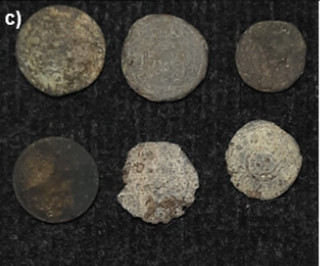 The wreck is believed to date to around the 15th or 16th centuries, making it about 500 years old, researchers said.
The wreck is believed to date to around the 15th or 16th centuries, making it about 500 years old, researchers said.
Among the objects found were a trove of coins, originating from Malaysia, China and Portugal, revealing the interconnected world in which the ship's occupants would have been part of.
At the time, the region served as a bustling maritime hub,
connecting the east and west via the Strait of Malacca — a trade route that remains crucial for global trade today.
To read the complete article, see:
Centuries-old shipwreck — with trove of coins — unburied from dry land in Malaysia
(https://www.miamiherald.com/news/nation-world/world/article287638660.html)
CANADA'S FIRST AMERICAN VICTORIA CROSS
In the did-you-know department, an American earned a Canadian Victoria Cross in WWI. -Editor
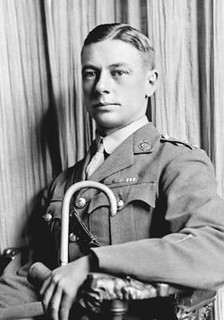 ‘I'm fed up to the teeth,' said Sergeant George Harry Mullin as he handed out rum rations to his Canadian comrades on Oct. 29, 1917. ‘Tomorrow morning it's either a wooden cross or a VC for me.'
He would soon be proven right on one of those counts.
‘I'm fed up to the teeth,' said Sergeant George Harry Mullin as he handed out rum rations to his Canadian comrades on Oct. 29, 1917. ‘Tomorrow morning it's either a wooden cross or a VC for me.'
He would soon be proven right on one of those counts.
Mere hours later, amid the Battle of Passchendaele, Mullin's gallantry and fearlessness,
as his Victoria Cross citation reads, earned him a place among a select few awarded the British Empire's highest military accolade.
Rarer still was his unique position within the esteemed and courageous group: an American-born recipient.
Mullin was not like the tens of thousands of U.S. citizens who crossed the border prior to America's own entry into the war. The Portland, Ore., native had learned to shoot a rifle while hunting prairie chickens near Moosomin, Sask., after his family moved there when he was two years old.
After the 1914 call to arms, Mullin eventually joined Princess Patricia's Canadian Light Infantry (PPCLI). Deployed to France, he quickly acquired a reputation as a skilled sniper—and for taking great personal risks.
Assaulting the Meetcheele ridge overlooking Passchendaele village, the men of PPCLI had already, in the words of one witness, been mowed down like wheat
when the Canadians came across a particularly menacing German pillbox.
Lieutenant Hugh McKenzie, a PPCLI officer attached to the 7th Canadian Machine Gun Company, rallied nearby survivors and launched a frontal attack against the stronghold. Intent on distracting the enemy gunners while others flanked the pillbox, the 31-year-old subaltern was killed in the charge.
McKenzie's efforts, which had the desired effect of diverting German fire, would be posthumously recognized with the Victoria Cross. Meanwhile, Mullin was in the process of earning his own.
The American carefully inched his way toward the concrete emplacement. When the right moment came, he leapt up and tossed grenades into an enemy sniper's post; the bombs instantly knocked it out.
Bullets ripped through Mullin's clothes—somehow without hitting him—as he rushed the next pillbox. Alone, revolver in hand, he clambered onto the roof before angling the weapon inside and firing. The German gunners fell.
Finally, having saved his pinned-down comrades, Mullin edged around to the post's entrance and compelled the remaining defenders to surrender.
Including the late McKenzie, four Canadian soldiers were awarded the Victoria Cross at least in part for their actions on Oct. 30, 1917. However, of those, Mullin had the distinct honour of being the only American-born recipient.
Even more interesting is this note about a Victoria Cross medal at the Tomb of the Unknown Soldier. -Editor
While five Americans have been presented the Victoria Cross—along with a debated sixth—a final American medal is held by the Tomb of the Unknown Soldier in Arlington National Cemetery, Va. This was a reciprocity act after the U.S. Congress approved awarding the Medal of Honor to the British Unknown Warrior. Both tombs now hold both decorations.
To read the complete article, see:
Canada's First American Victoria Cross
(https://legionmagazine.com/canadas-first-american-victoria-cross/)
U.S. MINT OATH OF ALLEGIANCE MEDALS
Stack's Bowers Numismatist Chris Bulfinch published an article on the U.S. Mint Oath of Allegiance medals. -Editor
After the seizure of the Southern branch mints by the Confederacy at the outset of the Civil War, the loyalty of Mint employees was taken seriously at the facilities remaining under federal control. Employees took an oath of allegiance to the Union and medals were struck commemorating it.
Anthony Paquet, then assistant engraver at the Mint, adapted a portrait used for the Washington Medal Cabinet Collection medal and prepared a simple reverse with text explaining that U.S. Mint OATH OF ALLEGIANCE TAKEN BY THE OFFICERS AND WORKMEN, SEPT. 2, 1861
encircled by a laurel wreath.
Cataloged as Baker-279, (R.7), Julian-CM2, and Musante GW-476, the medals were produced through the 19th century and into the 20th in three metallic compositions, according to Mint delivery records.
A 2023 CoinWeek article by Roger Burdette suggests that the oath taken by Mint workers and employees likely read like this:
I do solemnly swear (or affirm, as the case may be) that I will support, protect, and defend the Constitution and Government of the United States against all enemies, whether domestic or foreign, and that I will bear true faith, allegiance, and loyalty to the same, any ordinance, resolution, or law of any State convention or legislature to the contrary notwithstanding; and, further, that I do this with a full determination, pledge, and purpose, without any mental reservation or evasion whatsoever; and, further, that I will well and faithfully perform all the duties which may be required of me by law. So help me God.
Loyalty to the Union – or lack thereof – was a constant theme on tokens and medals of the period. Civil War tokens bore designs wishing death upon traitors and exhorting the preservation of the Union. The U.S. Mint produced a range of medals honoring successful generals, and some private citizens and numismatists like Augustus B. Sage commissioned medals commemorating battles and major figures.
To read the complete article, see:
DID YOU KNOW THAT U.S. MINT WORKERS TOOK AN OATH OF ALLEGIANCE IN 1861?
(https://stacksbowers.com/did-you-know-that-u-s-mint-workers-took-an-oath-of-allegiance-in-1861/)
ROSIE THE RIVETERS CONGRESSIONAL GOLD MEDAL
The latest Congressional Gold Medal went to Rosie the Riveters. Here's an excerpt from a New York Times report of the award ceremony, along with U.S. Mint images of the medal. Go ladies!! -Editor
Soon after the attack on Pearl Harbor in 1941, Marian Sousa moved to California to care for the children of her sister Phyllis Gould, who had gone to work as a welder in a Bay Area shipyard.
Just a year later, Ms. Sousa, at 17 years old, joined the wartime work force herself, drafting blueprints and revising outdated designs for troop transports. Wearing a hard hat and with a clipboard in hand, she would accompany maritime inspectors on board ships she'd helped design and examine the product of her labors.
She and her sister were just two of the roughly 6 million women who went to work during World War II, memorialized by the now iconic recruitment poster depicting Rosie the Riveter, her hair tied back in a kerchief, rolling up the sleeve of her denim shirt and flexing a muscle beneath the slogan, We can do it!
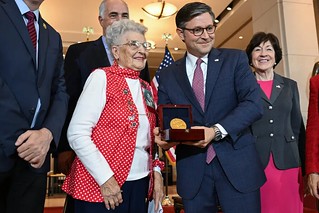 More than eight decades later, Ms. Sousa, now 98, gathered at the Capitol on Wednesday with around two dozen other so-called Rosies — many of them white-haired and most wearing the red with white polka dots made famous by the poster — to receive the Congressional Gold Medal in honor of their efforts.
More than eight decades later, Ms. Sousa, now 98, gathered at the Capitol on Wednesday with around two dozen other so-called Rosies — many of them white-haired and most wearing the red with white polka dots made famous by the poster — to receive the Congressional Gold Medal in honor of their efforts.
We never thought we'd be recognized,
Ms. Sousa said in an interview. Just never thought — we were just doing the job for the country and earning money on the side.
Congress passed legislation authorizing the medal in 2020, after years of urging by Ms. Gould, who died in 2021, and another Rosie, Mae Krier, who accepted the award on Wednesday on behalf of all Rosies in front of a crowd of roughly 600, including congressional leaders.
Up until 1941, it was a man's world. They didn't know how capable us women were, did they?
Ms. Krier said on Wednesday, to cheers. We're so proud of the women and young girls who are following in our lead. I think that's one of the greatest things we've left behind, is what we've done for women.
The Rosies went to work out of necessity. During the war, women were desperately needed to fill jobs vacated by men who had left to serve in the armed forces. Shortly after graduating high school, Ms. Sousa took a six-week course in engineering drawing at the University of California, Berkeley, and answered the call.
Many women were forced out of their jobs when the men returned after the war. Still, the experience shaped the rest of their lives and demonstrated that women could do work that had been traditionally reserved for men.
To read the complete article, see:
A Gold Medal for America's Rosies, the Women on the Home Front
(https://www.nytimes.com/2024/04/10/us/politics/rosie-riveter-congressional-medal.html)
Nice medal! I especially like the reverse. -Editor
The obverse design features five Rosies in profile to represent the diversity of women in the war effort. The inscription is ROSIE THE RIVETER.
The reverse features a Rosie with a wrench casually resting on her shoulder and a rivet in her other hand. A Liberty ship and M4 tank travel behind her, and a B-17 bomber flies above, representing the variety of equipment built by Rosies. A ring of rivets frames the design with windows featuring the inscriptions ACT OF CONGRESS 2020
and 1942-1945.
Designers for both the obverse and reverse-
Beth Zaiken (Artistic Infusion Program Designer)
Obverse Sculptor-Eric David Custer (Medallic Artist)
Reverse Sculptor-John P. McGraw (Medallic Artist)
For more information, see:
Rosie the Riveter Bronze Medal 3 Inch
(https://catalog.usmint.gov/rosie-the-riveter-bronze-medal-3-inch-MRRL.html)
PAPER MONEY OF FREDERICKSBURG, VA
An article by Neil Hening on the paper money of Fredericksburg, VA appeared in the Winter 2024 issue of The Virginia Numismatist from the Virginia Numismatic Association. With permission, here's an excerpt. Thanks! -Editor
Fredericksburg's first bank began when the state-chartered, Bank of Virginia in Richmond opened a branch in Fredericksburg in 1804. The charter authorized Fredericksburg as one of the first towns to have a branch. Many businessmen complained about the monopoly of the Bank of Virginia, and the state chartered the Farmers Bank of Virginia in 1812, with a branch in Fredericksburg. We are fortunate that two ‘minute books' for the Farmers Bank of Virginia survive for the main bank in Richmond. They are dated 1820 - 1827 and 1841 - 1853 respectively. Various branches of the bank are cited in these minutes. Germain to Fredericksburg, the minutes record that worn out and unusable banknotes were returned to Richmond for replacement and destruction. In 1824, the minutes reflect the destruction of $129,000 face value of banknotes ranging from $5 to $100 denominations, amounting to 3,236 banknotes. Two additional financial institutions opened in Fredericksburg and issued banknotes before failing.
Minutes survive from the Bank of Commerce, chartered on March 29,1851, whose board of directors held their first meeting on December 15, 1853. In 1861 notes from this bank received some notoriety as the local newspaper advised that counterfeit $10 bills were being circulated in Baltimore. The public was warned to be wary of a woman who passed the notes frequently changing her attire to avoid detection. This bank did not survive the Civil War and closed in 1865.
The second was the Fredericksburg Savings Institution whose minutes survive, and the board of directors held their first meeting on May 19, 1839. This institution was eventually driven out of business in 1844 due to competition with the Farmers Bank of Virginia.
Banks were not the only financial organizations to emit paper currency. Before the war, six different Fredericksburg merchants issued banking ‘scrips' as well as the Fredericksburg and Valley Plank Road Company. Although not chartered as banks, their notes served the same purpose in trade but offered no assurances of any kind. The issuers relied on good faith and their reputation in the community for their local acceptance.
On April 20, 1861, the Common Council of the Town,
officially the Corporation of Fredericksburg authorized issuance of small bills
to meet engagements of the corporation at the outset of the Civil War. Banknotes were issued in denominations of fifty cents, one dollar, and two dollars the following month, that circulated well and were worn out after just six months heavy use. These were payable in Virginia Bank Notes by the Chamberlain to the bearer on presentation of due bills to the amount of five dollars.
By September 1861, the town council authorized an additional $10,000 in notes. When the town was destroyed by war in 1862 many notes in the bank and courthouse were ‘carted off' by soldiers so that many survive today.
For more information on the Virginia Numismatic Association, see:
http://www.vnaonline.org/
LOOSE CHANGE: APRIL 14, 2024
Here are some additional items in the media this week that may be of interest. -Editor
Collectors, parent of Professional Coin Grading Service (PCGS) and owned by hedge fund manager Steve Cohen has inked a new deal with eBay. -Editor
As eBay continues to invest in the trading card space, the e-commerce company announced Wednesday three significant commercial transactions with Collectors, the parent company of PSA (Professional Sports Authenticator), the third-party authentication and grading provider in the collectibles industry.
The transactions include a trading card commercial agreement that aims to provide trading enthusiasts a seamless buying, selling, grading and storage experience. As part of the partnership, eBay and PSA plan to introduce a customer-centric product experience
over the coming months. Plus, PSA is launching a new service for customers to list trading cards on eBay as soon as the card is graded in order to accelerate the selling process.
Additionally, eBay acquired Collectors' auction house Goldin, a significant move that will greatly benefit collectors. The sale helps eBay expand the range of inventory for buyers as well as give Goldin sellers a wider audience.
eBay is also selling the eBay vault to Collectors, creating a new offering that merges the existing vault services. Launched in 2022, the eBay vault allows collectors to store trading cards that are valued at more than $750 in a secure, temperature-controlled vault.
To read the complete article, see:
eBay enters trading card commercial agreement with Collectors, acquires Goldin
(https://techcrunch.com/2024/04/10/ebay-enters-trading-card-commercial-agreement-with-collectors-acquires-goldin/)
Daryl Haynor passed along this article from The Hill about the State Quarter series, which started 25 years ago. Thanks. -Editor
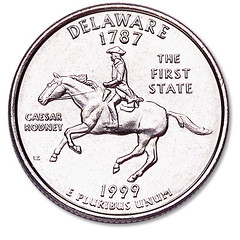 It's been 25 years since the U.S. Mint began producing arguably the most-collected coins: the 50 State Quarters.
It's been 25 years since the U.S. Mint began producing arguably the most-collected coins: the 50 State Quarters.
Just as the name implies, every state got its own quarter, sporting a design on the reverse reflecting an important feature, historical moment, or tagline (or, in some cases, all three). From 1999 to 2008, the U.S. Mint released five new quarters a year, following the order in which the states ratified the Constitution or were admitted to the Union.
More of the quarters released early in the program, like Delaware, were minted than others. A report from the Mint points to Y2K-related concerns in the late 1990s, followed by a slowing economy in 2001 for the production differences.
To read the complete article, see:
How rare is your state quarter — and is it worth more than 25 cents?
(https://thehill.com/homenews/nexstar_media_wire/4562515-how-rare-is-your-state-quarter-and-is-it-worth-more-than-25-cents/)
Some countries have laws against "abuse" of their banknotes. Here's a recent story from Nigeria. -Editor
In a move that has captivated public attention, Idris Okuneye, widely known as Bobrisky, one of Nigeria's most prominent and controversial figures, has been arrested on allegations of abusing banknotes. The incident reportedly occurred during a high-profile film premiere in Lagos, casting a spotlight on the celebrity known for her gender identity and vibrant social media presence.
Authorities, speaking with the BBC, explained that Bobrisky's actions involved "spraying" money - a practice where banknotes are thrown into the air as a gesture of appreciation or celebration. While this tradition is a common sight at Nigerian weddings and festive occasions, it technically violates laws against the mishandling of national currency. Such acts, which result in money being scattered and potentially trodden upon, carry a risk of six months imprisonment, although legal actions are infrequently pursued.
The event that led to Bobrisky's arrest was the premiere of "Ajakaju," a film eagerly anticipated by fans of Eniola Ajao, an acclaimed actress and producer. The premiere took place at Film One Circle Mall, located in Lekki, a prestigious district of Lagos. Footage from the event, showcasing the act of spraying money, rapidly spread across social media platforms, likely precipitating the authorities' decision to intervene.
Throwing money around is legal in the U.S., so feel free to swing by my house and spray it with a money bazooka. -Editor
To read the complete article, see:
Nigerian Celebrity Arrested for Banknote Abuse
(https://www.africanexponent.com/nigerian-celebrity-arrested-for-banknote-abuse/)
DU SIMITIERE SKETCH DISCOVERED
Michael Oppenheim forwarded this Washington Post article about the discovery of a rare Revolutionary War drawing by an important colonial figure with a numismatic connection - Pierre Eugene Du Simitiere was an early collector and founding father of American numismatics that Joel Orosz wrote about in his 1988 book, The Eagle that is Forgotten. -Editor
After waiting for two years, Matthew Skic was excited to visit the New York City apartment of a collector of early American art. The curator of exhibitions at the Museum of the American Revolution in Philadelphia had heard reports about Judith Hernstadt's impressive array of artifacts from the colonial period, which she had gathered over the past 40 years.
Because of the covid pandemic and other commitments, Skic had to delay his tour until August 2023. His patience was rewarded when he witnessed Hernstadt's assemblage of prints, paintings, furniture and other rare items from the late 18th century.
Then Hernstadt took him into another room, and when he saw a framed image hanging on the wall, he recalled, My jaw dropped.
It was a pen-and-ink sketch of 18th-century soldiers walking next to a horse-drawn wagon that included two women and a baby. Depictions of an army on the march from that era were rare. He wasn't sure which army it was until he spotted an important clue.
My heart was racing,
he said. One of the soldiers was wearing a distinctive American garment called a hunting shirt. It was a typical garment of the Continental Army, worn by American soldiers.
Skic would later discover that — unbeknownst to Hernstadt — she was in possession of one of the earliest eyewitness depictions of American troops and their female companions during the Revolutionary War. The drawing had been crafted by an artist who played a prominent role in the iconography of the new American government, though neither Hernstadt nor Skic was aware of it at that moment.
Until Skic's discovery, the oldest known artwork depicting female camp followers was a watercolor from 1782 by Pierre Charles L'Enfant, the French engineer who laid out the street plan for Washington. In 2017, Skic had been part of the team that identified L'Enfant as the artist who created a panoramic painting of Washington's army at West Point, N.Y. He wondered if L'Enfant could have also drawn Hernstadt's sketch, but historical records showed he had not been in Philadelphia in 1777.
Skic continued searching for the artist and settled upon a prime suspect: Pierre Eugene du Simitiere. The Swiss-born philosopher and artist had settled in Philadelphia in 1774. Five years later, he completed one of the first known portraits of George Washington, which was featured on the 1791 one-cent coin.
Skic was familiar with the artist. In 2013, as an intern, he had studied the works of du Simitiere, who was best known for submitting the first proposed design for the Great Seal of the United States. Though his idea was rejected, the Founding Fathers seized on two elements of his design: the phrase E pluribus unum
(Latin for Out of many, one
) as the country's motto, and the all-seeing eye (known as the Eye of Providence) that remains on the one-dollar bill.
The museum curator consulted with art historians familiar with du Simitiere's other works, then presented samples of the artist's letters to handwriting experts so they could compare them to the inscription on the sketch. In February, Skic and his colleagues announced their finding: It was du Simitiere.
Joel Orosz writes:
"Many thanks for sharing news of this cool find! These pen and drawings have Du Simitiere's signature you-are-there look, and also his customary thriftiness, being drawn on both sides. I'm glad they have ended up in the Museum of the Revolution, which is where they truly belong."
To read the complete articles, see:
Sketch in N.Y. apartment turns out to be rare Revolutionary War drawing
(https://www.washingtonpost.com/history/2024/04/14/revolutionary-war-sketch-simitiere-museum/)
Rare Eyewitness Sketch of American Revolutionaries Found Hanging in a Collector's Bedroom
(https://www.smithsonianmag.com/smart-news/this-eyewitness-sketch-of-american-revolutionaries-was-hidden-in-a-private-collection-180984047/)
To read earlier E-Sylum articles, see:
PIERRE DU SIMITIÈRE'S PORTRAITS, 1783
(https://www.coinbooks.org/esylum_v13n40a07.html)
BOOK REVIEW: THE EAGLE THAT WAS FORGOTTEN
(https://www.coinbooks.org/v22/esylum_v22n18a08.html)
REVIEW: DU SIMITIèRE AND HIS MUSEUM
(https://www.coinbooks.org/v23/esylum_v23n02a06.html)
PIERRE EUGèNE DU SIMITIèRE (1737-1784)
(https://www.coinbooks.org/v24/esylum_v24n09a22.html)
FEATURED WEBSITE: WHITMAN BRANDS
This week's Featured Website is the new Whitman Brands home.
CDN Publishing and Whitman Publishing have united, creating a historic moment in numismatic history.
Whitman's legendary brands, such as the revered Red Book, Blue Book, and an expansive line of folders, albums, and supplies, have long dominated the retail landscape. Meanwhile, CDN Publishing boasts esteemed wholesale brands like Greysheet, Greensheet, CPG, CDN Exchange, and the Banknote Book.
Whitman Brands marries CDN's data-driven wholesale expertise with Whitman's retail prowess, offering a comprehensive and intellectually rich coverage of collectibles. Embrace the heritage, explore the vast array of publications, and become part of a movement that celebrates the richness of numismatics.


